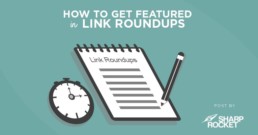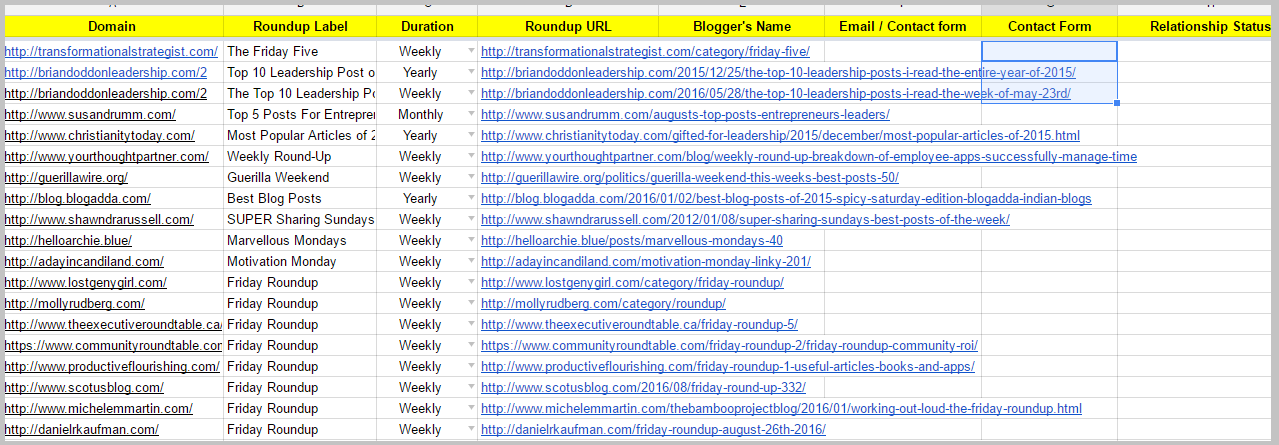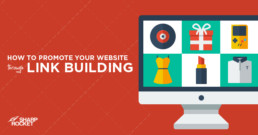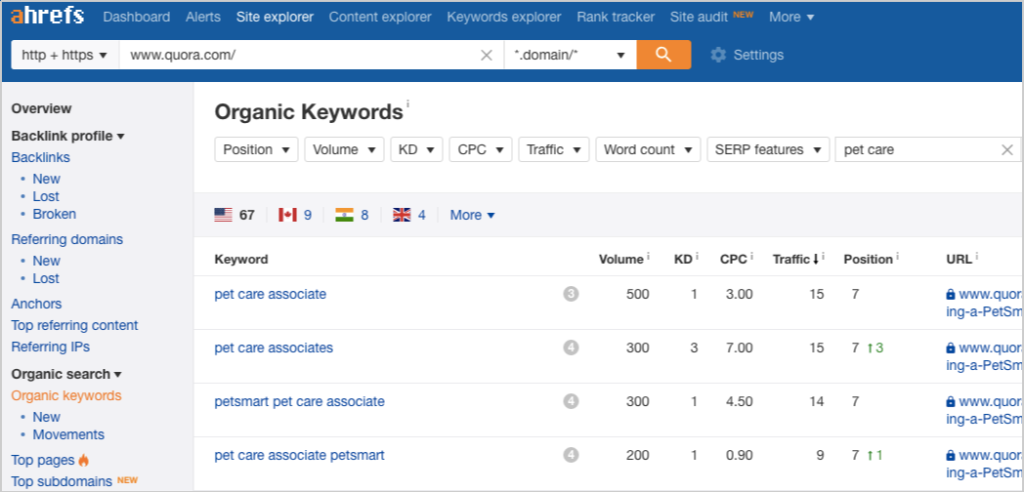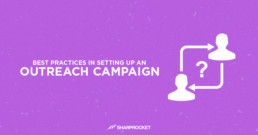10 Gmail Extensions for Email Outreach and Link Building
Gmail has been widely used as a common outreach platform for marketers reaching out to webmasters, publishers, and other link partners. In hopes for any action from the end-user (i.e. a link or social share), marketers send initial pitches and engage respondents until the desired action is made.
Today, we'll cover 10 Gmail extensions that will allow you to speed up some email outreach processes for link acquisition and other content promotion initiatives.
1. Mailtrack. io
Cost: From Free to $4.99 per month subscription ($2.49 per year - a huge discount if you subscribe annually)
Useful for: Email tracking
![]()
Mailtrack.io allows you to check if your emails were sent and opened by recipients. You can even see how many times and in what particular hours your emails were opened by clicking the Mailtrack. io section of the email.
![]()
Knowing how your emails were treated will help you then, take appropriate actions.
For example, if your email hasn't been opened for days and weeks, it is unwise to send a follow-up email when the original one was not ready yet. You may, in this particular instance, try to look for another contact person and his or her email address from the same page or website. Reach out and ask if he or she can direct your message to your desired contact.
Mailtrack.io also notifies you in real-time when you are logged into your Gmail account.
If you are subscribing as a Pro user, you will have access to its additional features such as click tracking (knowing when your recipients click on the links in your emails), and reminders (receiving email notifications if your emails have not been read after 24 hours). Both of these features help you better monitor your outreach accounts.
2. Grammarly
Cost: From Free to Premium Accounts ($29.95/month or $11.66/month for an annual subscription)
Useful for: Email grammar check

Every email needs to be checked for any grammatical errors, tone, style, messaging, and any other factors that make them successfully opened, read, and responded to.
By integrating Grammarly into your Gmail account, you will quickly notice if the content of your email needs grammar improvement. You can correct any errors as quickly as possible and send a beautifully touched pitch to your potential link partner.
You will avoid the painful mistakes of not receiving a positive response just because one word or phrase confuses the entire message of your email.
Of course, there are words or phrases in certain lingos that should be added to make your email relevant to its end-user. In that case, simply ignore red underlines of Grammarly.
3. Unroll. me
Cost: Free
Useful for: Email inbox cleaning
There are websites wherein the only way to contact them is through their contact forms. If you're in a hurry to fill out those forms, you may have overlooked the default check box option for email subscription updates (normally located at the bottom of the contact form).
Several unnecessary (promotional) email updates like that, from different sites will now clutter your Gmail inbox (in which the inbox is supposedly created for linker outreach purposes only).
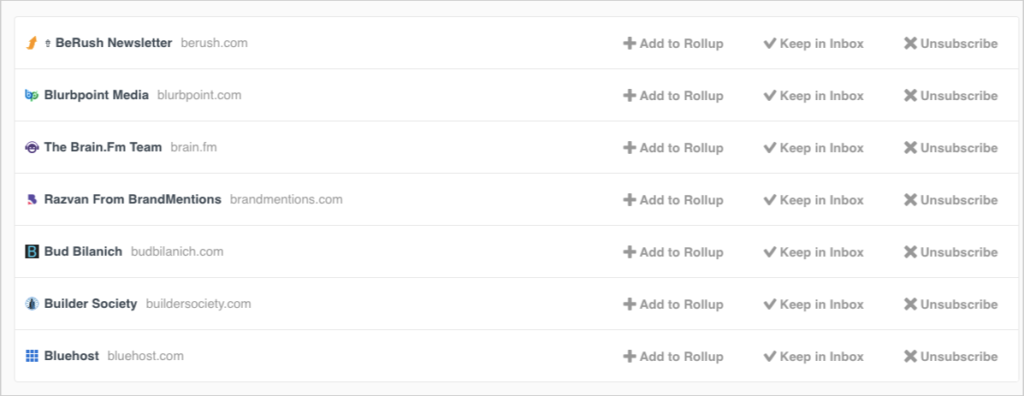
Unroll.me helps you easily clean your inbox by unsubscribing from emails you don't want to see - these primarily include email updates from websites you reach out via their contact forms. Unless you are really interested in their updates, it is best to delete them to focus you more on outreach emails you have to reply to.
4. Gorgias Templates
Cost: Free
Useful for: Initial pitch, Email conversations
If you ever wonder how you can scale your outreach with ease, then you probably need Gorgias Templates.
By integrating this extension into your Gmail account, it allows you to quickly add an email template (or semi-outreach template) straight to your email. It is quite similar to Gmail's Canned Response but offers lesser friction by choosing and using any of these two methods.
First, you can click on the G button and the appropriate template for your email. The email template will be generated automatically.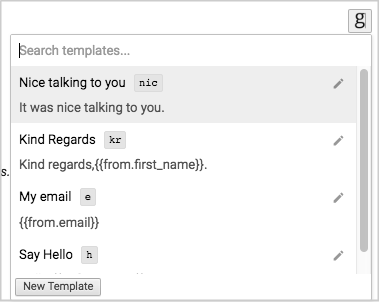
Second, you can type in the shortcut text and click TAB on your keyboard to insert templates quickly.
You don't have to copy and paste your email templates when you use Gorgias Templates. With a few clicks and shortcut tabs, you'll be able to send hundreds of emails within hours. So if you are ever looking for high efficiency in outreach, then this Gmail extension should be your first choice.
5. Discoverly
Cost: Free
Useful for: Customizing email pitches
Knowing about your recipient's interests, needs, and/or wants is vital in customizing your email pitch. The simplest way to do it is to use Google to research and collect these details, but doing so for hundreds of your contacts will definitely consume a huge chunk of your time.
Discoverly, a Gmail extension, can be your alternative tool to quickly view your potential link partner's details and go quickly to their social profiles - if you want to.
You don't have to switch your tabs to and from your Gmail platform, all you have to do is to click on your contact's email address and a Discoverly section will pop up in a second.
6. Right Inbox
Cost: From Free to monthly subscription of $7.95/month ($5.95/month for an annual subscription)
Useful for: Customizing email pitches
Gmail adds another feature in their platform that tells you if an email hasn't received a response from your end (or needs a follow-up).
That's an interesting Gmail feature now if you ask me. But still, I am yet to come across a feature on their tool that allows you to schedule emails on a specific day and time.

RightInbox, a freemium tool offers you the ability to schedule your emails at your preferred day and time. Not only that, if you want to get reminders from recurring emails (not necessarily the ones that need follow-up), but emails you should respond to within the day, that in itself helps you organize your email communications.
7. Inbox When Ready
Cost: From Free (14 days trial) to $4/month (Pro) and $30/month (Team)
Useful for: Focus on email conversations
Distractions may come your way when you're doing outreach. These distractions include promotional newsletters from websites you've subscribed to unintentionally, i.e. default check on boxes on websites' contact forms, alert notifications of reading emails from another Gmail extension or even, failed messages.
If you're not prepared for this, you may lose your focus instantly and could totally affect your deep work activities (discussion with your content development team, brainstorming on new linkable ideas, and so on).
Inbox When Ready solves that problem of losing your focus by hiding your inbox by default.

You can even define a schedule when will your inbox be locked out so you can batch processing of your emails at optimal times. Aside from scheduling inbox lockout, Inbox When Ready also shows you how much total time you want to spend on organizing your email communications.
In addition to features, you can hide category tab notifications that may distract you when replying to potential link targets. Instead of you opening or even reading promotional emails, you can disable them so you can focus on your Gmail's primary inbox.
8. Checker Plus for Gmail
Cost: Free
Useful for: Initial pitching, Email conversations
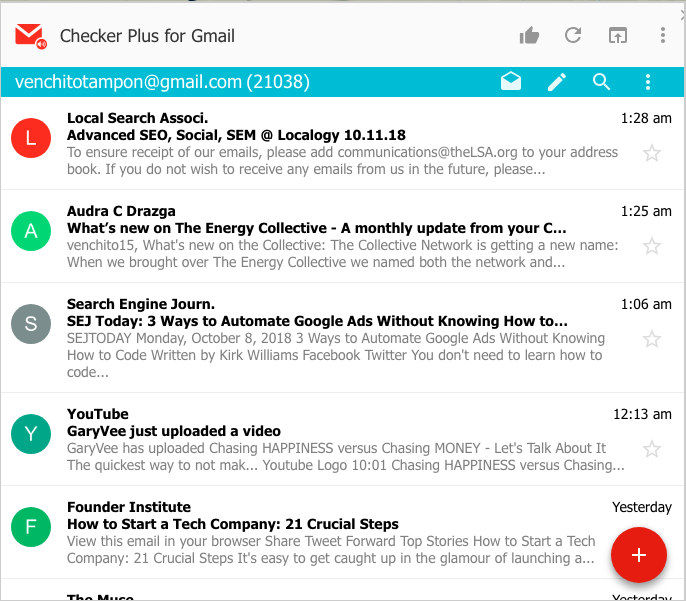
Ever had a difficult time switching to different Gmail accounts which serve different purposes or are used for different outreach personas?
The hassle of signing out in current Gmail account and signing in to another one could be solved by installing Checker Plus for Gmail.
This Gmail extension allows you to easily manage multiple accounts. You can even set which account you want to pop-up notifications on your browser, and even read or delete emails without opening Gmail.
Checker Plus for Gmail is a very effective tool in ensuring your Gmail outreach accounts are properly managed. It's definitely a must-try if you have several outreach personal accounts.
9. Streak
Cost: From Free to $49/month (Professional) and $99/month (Enterprise)
Useful for: Initial pitching, Email conversations
One differentiator of Streak from other similar Gmail inbox management extensions is its ability to organize communication flow. Meaning, you can create different categories of your outreach flow by labeling which emails aren't interested with your email pitch, emails that are likely to give you a link, or emails that need follow-up sooner.
Streak also makes it easy to share emails across the team without the need to forward or even your cc team members.
If you prefer customer relationship management or CRM-like structure Gmail extension, Streak fits your choice.
10. KeyRocket
Cost: Free
Useful for: Initial pitching, Email conversations
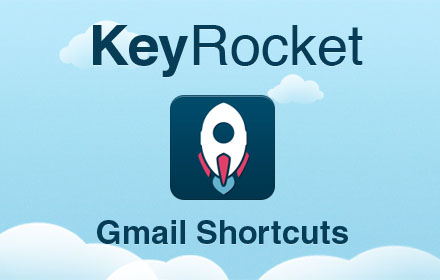
Shortcuts in any form or area make you more efficient than ever.
But the only reason why we don't maximize them to some extent is we don't really know them.
There's a Gmail extension tool that will keep you and me semi-memorized keyboard shortcuts specifically on Gmail — that is, KeyRocket.
KeyRocket's shortcuts come just at the right time when you need it. For example, if I need to go to my inbox, what I need to press on my keyboard is G then I.
KeyRocket tracks your movements and suggests appropriate shortcuts to help you get things done faster. It's like an assistant working beside you that provides quick and helpful tips and tricks.
There you go, these are 10 Gmail Extensions that I've found to be incredibly valuable in managing your Gmail outreach accounts. Try one, two, or five of these tools, and let me know in the comments section how they've helped you in your outreach efforts.
For Further Reading:
- Strategy for Follow-Up Emails to Link Prospects
- Six Small Differences You Can Make to Your Email Outreach
Need help with your outreach campaigns? Check out our link building services here.
Smart Link Prospecting: Finding The Most Responsive Link Targets
Have you ever prospected thousands of websites only to find out that most of them are the most irresponsive targets for your outreach emails?
It happens all the time — only if you don't do smart link prospecting.
In today's blog post, you'll discover how to find relevant prospects that are likely to respond to your pitch — bringing much value to your business.
You'll also learn ways on how to re-engage them for future link opportunities, even after you've landed links on their websites.
Before we dive into the methodology of effective link prospecting, let's first understand what smart link prospecting is.
What is smart link prospecting?
Smart link prospecting is an intelligent way of doing your link prospecting initiatives so you would avoid the headaches and pains of not getting the results you're looking for.
It involves understanding these three core elements: objective, audience targeting, and metrics.
Objective
Like any plan or campaign, you have to start with your objectives. What are you trying to achieve with prospecting?
Are you looking for people to engage and promote your newly launched content asset? Are you aiming to build relationships with key influencers and content creators who've linked to your competitors so you can get them to promote your future assets through links?
What is it that you want in link prospecting?
It's easy to dive in without these objectives. But this would only make things worse if you can't have specific objectives in mind when doing link search.
Audience Targeting
Seeking the wrong people is the worst link prospecting in the world.
By targeting the wrong people, you ended up way wasting your resources — time, money, staff resources, etc.
What you want to do is to identify the right groups of people to target for links.
If you've been in sales, you know the types of prospects: cold, hot, and warm. This same principle is something we can use for link prospecting.
Basically, warm prospects are people who are familiar with your brand. They know about you either they've read your content piece in the past, downloaded one of your books, partnered with your brand for retailing, or other activities that show they have good knowledge about your site.
Hot prospects are your existing link prospects. They either be recurring linkers of your content (constantly sending you organic links) or one-time linkers in any of your content pieces in the past.
The smart way of doing link prospecting isn't only targeting the most relevant link prospects (that's pretty obvious), but starting off with people who've had an established familiarity with your brand (warm and hot link prospects).
Metrics
Setting standards for your link prospecting is obviously a smart way given that you're maximizing every opportunity to get these link building targets into linking to your content.
Link building is a value exchange.
If you find quality link prospects, you could give them the quality value they deserve depending on their needs. Vice-versa. They would also provide you with a link you need for your site.
You can check out this guide on how to use link metrics.
3 Smart Link Prospecting Approaches
The smart way of doing link prospecting isn't only targeting the most relevant link prospects (that's pretty obvious), but starting off with people who've had an established familiarity with your brand (warm and hot link prospects).
1. "Linkeratis" Movement
Linkeratis are web users who have the capacity to link to a certain website (the destination page) from a domain/page (the linking source) to where they have access to.
Smart link prospecting is understanding where these linkeratis are engaging.
You'll realize that they've been following your brand for a while and have proven to link to you in the first place.
The "linkeratis" movement is creating a list of all your existing linkers and taking them into another link building action.
How to find these linkeratis?
1. Top linking pages
The most obvious approach to finding these linkers is to use Ahrefs or other link analysis tools to find people who've linked to your top pages.
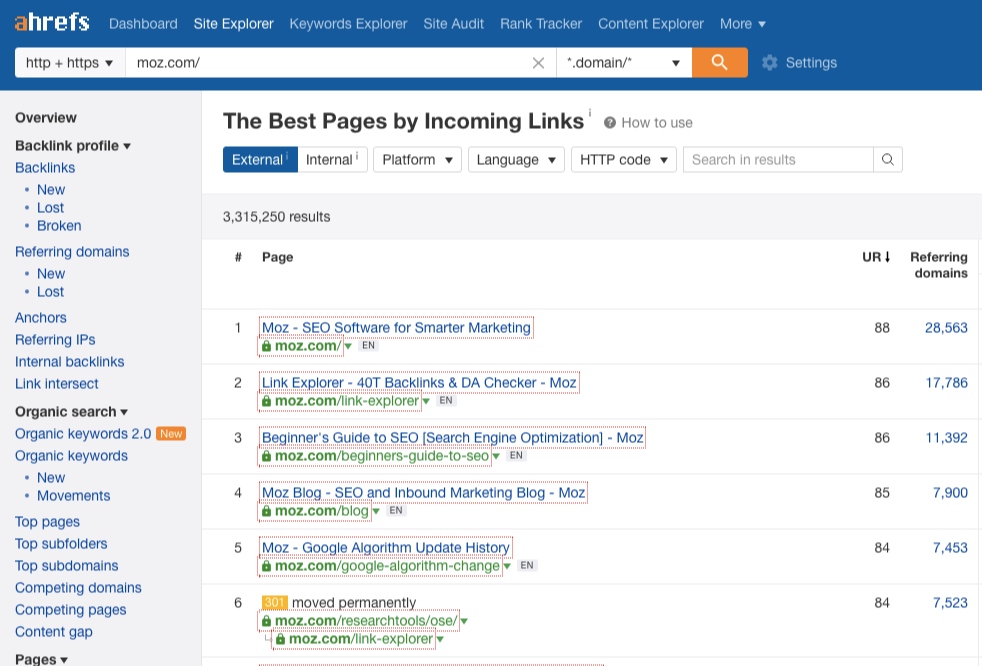
2. Interviews
People who've interviewed you for various reasons — either for a round-up post, a "quote" or insight for a story published in online or offline collaterals.
You could simply find them by typing in your "BRAND" "interview" or "NAME" "interview". If you're an enterprise, this might require more effects in digging which publishers have covered you previously.
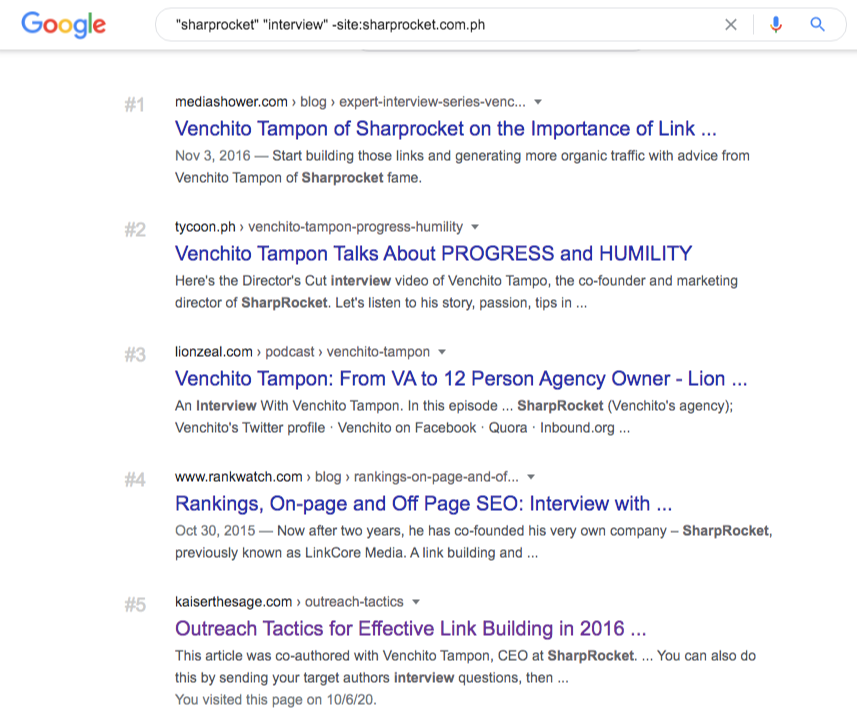
3. Content republishers
Have you published a visual asset, let's say an infographic, and someone used it on their blogs?
Simply, these are content republishers.
They are part of the linkeratis, as they've seen the perceived value in your content piece through externally linking to your page.
You can use Tineye and BrandMentions to find republishers of your content.
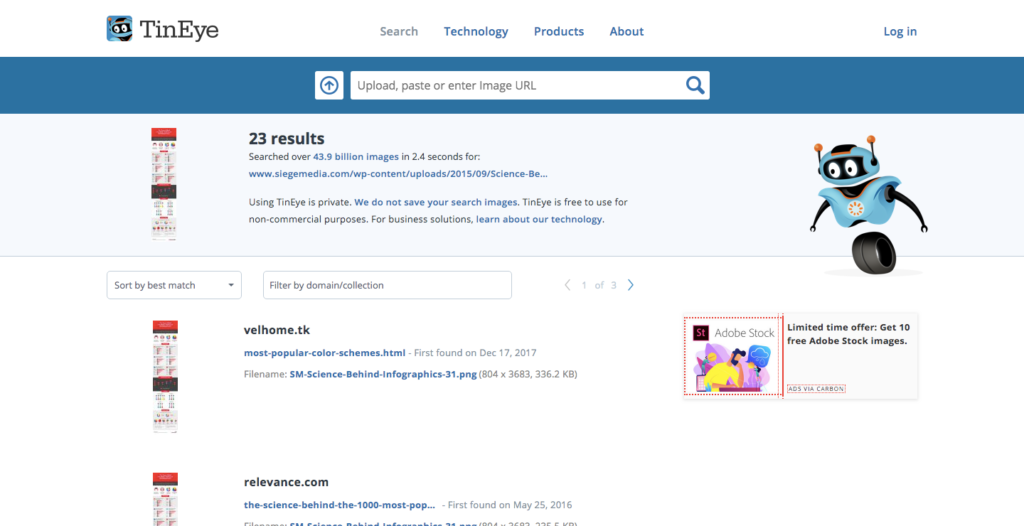
2. "Fan mode" Prospecting
Your fans care about you, particularly the ones who are raving for your next piece of content. They are either email subscribers or active social followers.
You won't know if they are good link prospects, not until they've shown interest to link to you.
First, you have to be able to find who they are.
There are many social media tools - those web products that would allow you to get a list of social sharers of your content.
This is important given that you have to be looking for people who've shared your content but haven't linked to you. With little nudges in your outreach, you could get them to take that link placement action.
In discovering these social media fans who became your content social shares, see if they have active blogs/sites or contributors or columnists on other industry publishers.
You want to make sure that they have the capacity to link to your content.
3. "Inside job" Prospecting
Being part of the parties is a good way to engage your target audience.
If you're not yet part of online communities in your industry, you're missing out on a lot of linking opportunities and branding exposure.
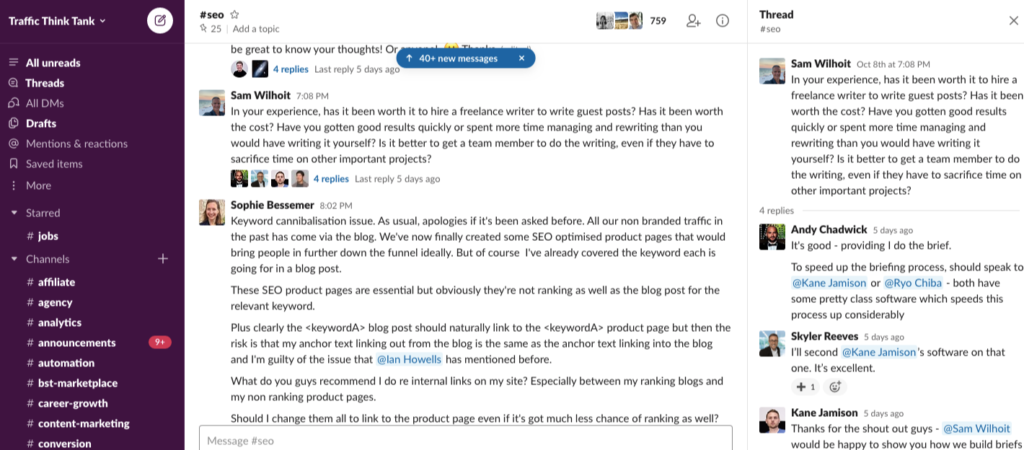
Find active communities, industry groups (i.e. Facebook groups), and slack channels you can involve yourself in.
This is what we call, "inside job" prospecting. You first engage in a community. You answer questions you think you could provide more value through your experience, expertise, or simply your own insights on the topic.
You don't appear to be pushy, or out of the party in the online community, but rather a person who cares to provide value to the audience.
What you want to do is to start following active community participants — target those either with highly engaged followers, part of the top community users, or co-hosts of online events (i.e. webinars).
Know what makes them tick and share their posts to get you on their radar.
Familiarity With Your Brand
As you grow your brand, people become more familiar with who you are and what you do.
The people who will likely show interest in linking to your site are the ones who already acknowledge you as a good value creator.
With the right objectives, proper audience targeting, and understanding of what metrics fit you — based on your industry and context, can help you prospect for link targets who are responsive to your outreach pitches.
Other Useful Resources:
- How Many Websites Your Link Prospector Should Be Looking For?
- Hitting Your Number of Acquired Links Per Month
- What Can We Automate in Link Building
Four Factors That Help a Content Gain Organic Links
While link building is a conscious effort-driven activity to pursue the right types of links, any properly executed content strategy will result in organic links. They call this "link earning" whereby links acquired are by-products of the receptivity of the linkable audiences to your content assets.
The question we need to answer is, "What makes a certain piece of content organically acquire the links?"
There are two important factors that can help us answer the question: context and timing
When the context is appropriate to fulfill the needs of its intended audience and is better perceived as link-worthy than its competing resources, there's a likelihood of an organic link building process coming into play.
When the timing is just as right such that the content is needed by its targeted users, whether they're looking for it and are spotted right in front of their eyes, the same organic linking is possible.
Here are the factors that make a content piece likely to gain organic links in the process:
1. Content is referential
This basically means that there is an intent of using the type of content as an additional resource or reference in the creators' work.
Link referential activity happens when posts are researched by writers using search engines or by following the hosting blog (given its authority and established brand) and using them to source more information from the texts or to point out readers for additional learning.
A survey is a type of content that is referential in nature. If it's well-researched and has accurate findings, it could gain organic links from bloggers who're looking to support their opinions, statements, and thoughts (and would add help in increasing their content's credibility to the market).
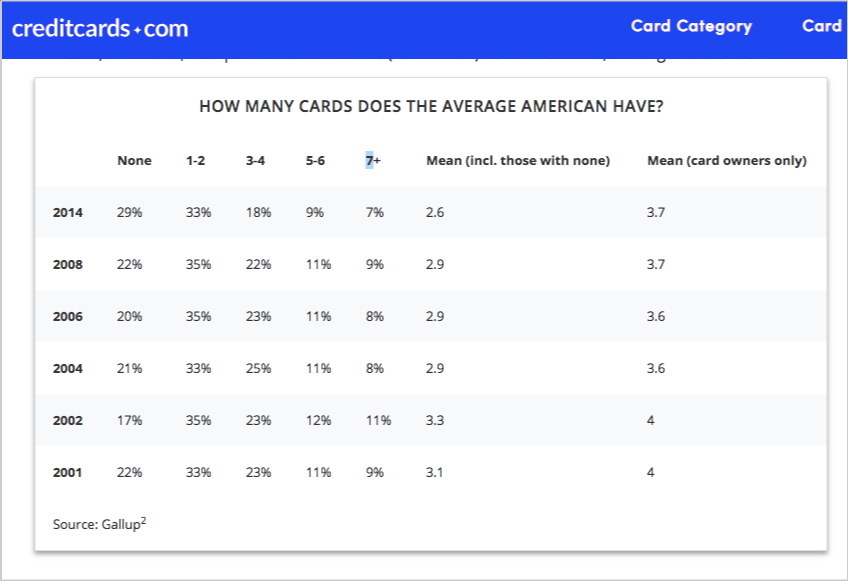
If you're pursuing .edu links, for example, one way to catch interest from student blogs is to choose topics that have high potentials of getting referenced by the page/site of students and faculties and get them published on your blog.
You can interview professors on the topic of school interests, collect their input, and produce it as a content asset.
2. Content is searchable
To enhance organic linking, a content piece must be well-optimized to rank in search results for its targeted keywords. If it is found in SERPs by people in the content creation process - researchers, bloggers, and other content publishers, you can really scale the link attraction process.

Not only that, but you should also produce evergreen content on your blog, but make sure this content is well-researched to dominate the top spot of search results.
The searchability of your content allows non-industry publishers to quote or cite you in their own published works, which would expand the reach of your assets. This is a tangential approach to producing more links to non-targeted markets yet is highly relevant to your brand.
3. Content is shareable
If a content piece gets more social shares than other average pages are capable of getting, it can multiply its effect in introducing your web asset to a new set of potential readers who might use your page as a reference in their future publishing works.
If the social shareability of your content continues for weeks (may not be extended to a year and rarely does it happen, unless readers found it and intently share it again in social networks), you are increasing the likelihood of boosting a good number of links in its initial promotion.
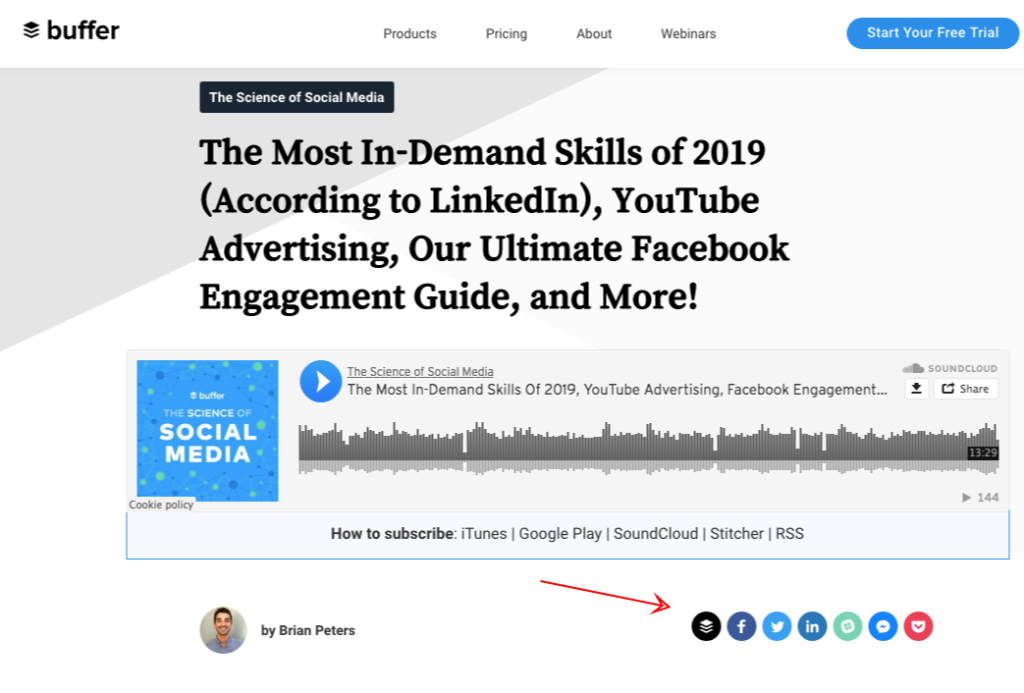
It is essential to make it easy for your readers to share and even follow you on social networks. Those social sharing buttons will form a great role as a call-to-action on your posts.
Another approach to scaling the process is for your own party to share others' relevant content, especially those pages coming from individuals and entities who have substantial followers in their industry.
The value of building alliances and reciprocity will go a long way in making your content more shareable with the masses.
4. Brand hosting the content is trust-worthy
Aside from the content itself is appealing in design and its included visuals, another signal that will be of importance for organic linking is the exact website where the page is hosted.
Whether it is a sales-oriented page or a page for linkable purposes, who sources the content is a great determining factor in whether a piece is likely to be referenced by publishers.
The initial confidence brought by the authority of the entity/brand is so crucial that it speaks the reason behind the number of organic brand mentions in products of many brands online.

Because customers got great experiences using the product or service, it's a natural thing to quote it on their own blogs, forums, or micro-communities. This kind of organic linking activity isn't something any brand can replicate because the brand is well-known for its greatness in customer service.
THE UNCONTROLLABLE AND INVISIBLE PART OF LINK ACQUISITION
The type of content and relationships between linking partners may not be publically present, but they form part of what makes organic linking more like an auto-pilot.
If a content piece is referential, searchable, shareable, and is hosted by a trustworthy brand, the art of organic linking becomes more realistic in the scene.
The process involved in it may require conscious effort in consistently putting out content that is well-curated or well-written. The rewards from the process is astounding, a content publisher will repeat it regularly.
21 Effective Ways to Drive Traffic To Your Website
Whether you’re a newbie blogger, business owner, or a big brand, you’d always ask the question, “how can I drive (more) traffic to my website?”
There are lots of tricks and strategies scattered on the Internet on how to do that exactly, some aren’t applicable in your industry, others are executable. However, if you’ve tried tweaking them to suit your needs, it might be one of your traffic generation strategies to look over this 2017.
Here are 21 ways on how to drive traffic to your website with steps to execute them right in order to grow your online business this year.
Let’s get started.
1. USE PHOTO ALBUMS FOR FACEBOOK POSTS
I’ve been testing Facebook as one of my top referring sources for my career development blog (still under content development test).
There are tons of content you can actually create that can generate more followers to your page, which will drive a good amount of traffic to your blog/site. But what I’ve found out to be most effective are content types that are native in Facebook: videos (with transcripts), how-to album posts, and quotes with an unexpected hook.
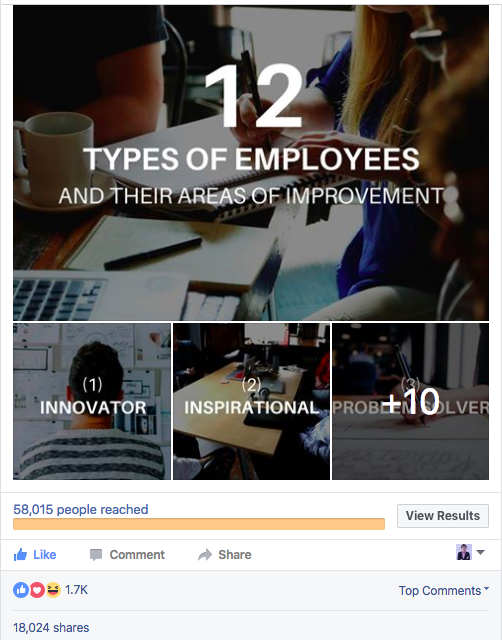

Check out how I increased my Facebook page from 2,500 likes to almost 26,000 followers in 2 months.

What’s more amazing is the virality of these single pieces of content that only takes a few hours to create.
There is only one link displayed on the page, evenly placed it on the right side, which means people who’d been through my page, engaged with my content and wanted some more, clicked on the website and read the blog posts.
If you’re not that photo-editing savvy, there is Canva that can help you scale your visual content creation process (20 minutes is what it takes).
Protip: Use Picjumbo.com and Google Image search (tools - usage rights - labeled with reuse for modification) to download non-copyright images, so you don’t have to worry about this issue later on.
2. VIDEO OUTREACH WITH USELOOM
Some industry bloggers receive “guest blogging pitches” almost every day, especially if they’ve had a huge amount of followers/visitors and authority, that people want to absorb a portion of those followers and drive them to their own sites.
This made it a lot more difficult for your outreach emails to get opened and to receive a “go” for your guest post topic”.
Standing out among these “guest blogging emails” by providing as much value as you can is the key to getting as much value in return for your brand.

You can screen record yourself proposing three or four relevant blog topics customized for the guest blog. Scale the process of video outreach to 30 or 50 guest post prospects using UseLoom, which is a Chrome Extension tool.
3. PUT DESCRIPTION LINKS TO YOUR YOUTUBE VIDEOS
There are approximately 81 million videos uploaded currently on Youtube. That insane number of content is enough to get yourself into the Platform and start producing engaging and informational content.
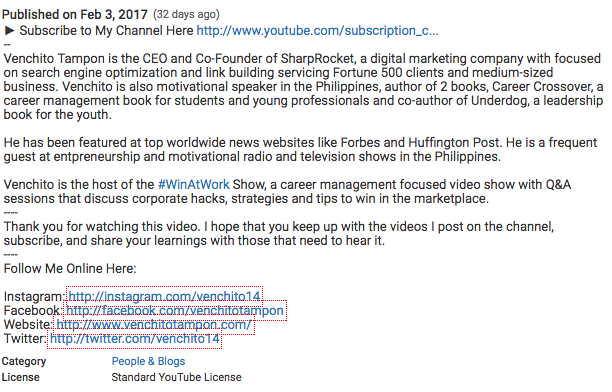
How can I drive website traffic from Youtube?
Put a link to your website in the description box of your videos. When someone watches your video and wants to know more about your brand, they can easily click on the link.
4. DO OUTREACH TO BE INCLUDED IN EMAIL ROUNDUPS
Basically, link roundups are pages that include external links to the latest useful resources and content curated by the blogger himself. Its value proposition is helping readers to get updated with the latest trends, tips, and strategies on a particular topic, without the need to scour every single blog and check their latest articles.
If you haven’t got a link from a link roundup in your industry, you’re missing a good opportunity to drive traffic to your website.
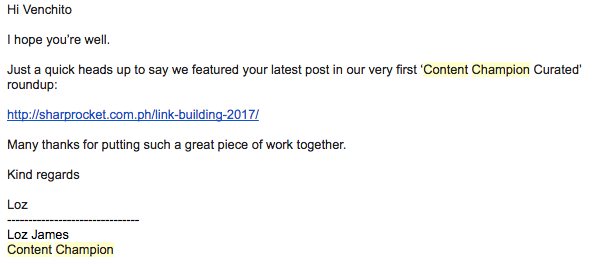
A simple outreach to these link roundup curators allows you not only to receive referral traffic from their link roundups (if your content has been featured), but also gives you the leverage to build relationships with them, that will soon propel your brand to other sets of targeted audiences.
5. CREATE A COMMUNITY-BUILT FACEBOOK GROUP
If you’ve got the audacity to create a community, creating Facebook groups is for you. Its culture of value exchange can help you generate a certain number of visits for every content you post.
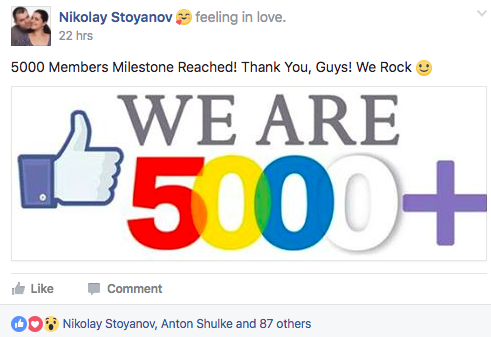
If you think it’s not for you, then invest in spending 10 to 15 minutes of your day answering questions on a well-built community Facebook group. Here are some examples of answers I shared in the past few days.
You can put a link if it’s something that’s relevant (see example below) or just is direct with your answers.
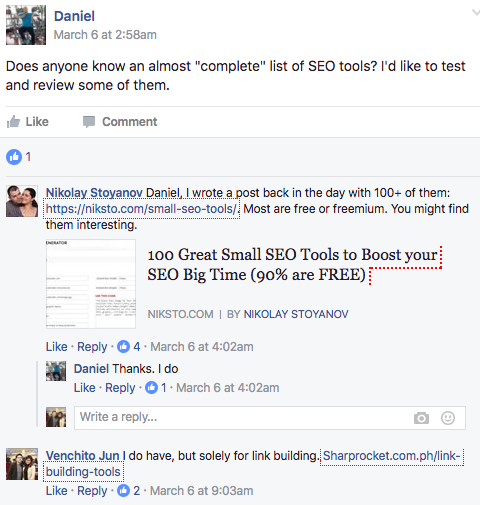
You won’t get direct traffic instantly by doing so. But with consistent efforts to answer industry Q&As can help you build your brand as a go-to source of information on a particular topic theme.
6. NEWSJACK CONTENT CREATION
Any industry has its own updates and trends that you can leverage as new content for your blog.
Because of the luxury of a good amount of searches by people following those topics, you are able to give a boost of targeted traffic to your site.
Start by creating a list of industry influencers. This way, you’ll be able to see what trends/topics people are watching out for.
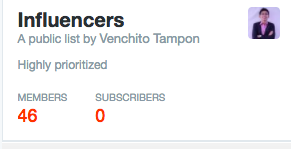
Then put in the work to create content that doesn’t just announce an industry trend/update but delivers value by sharing your own insights to the topic (that would differentiate you from other content publishers in your space).
7. REPURPOSE EXISTING CONTENT TO OTHER CONTENT FORMATS
It’s easy to dive into the new content ideas you’re trying to come up with for your brand, but when you start looking in your content inventory, you’ll start seeing “high-performing assets” that can be repurposed into other content formats.
If it’s a how-to or list type of post, turn it into a slide presentation then upload it to Slideshare. Then, redistribute to other visual directories.
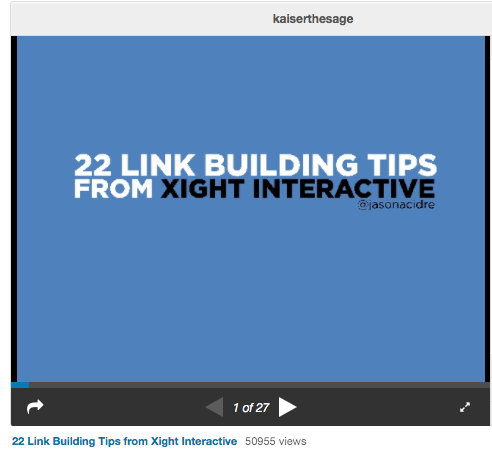
Video content can also be transcribed and published as an article, let your editor execute the proofreading. Publish it in Medium to gain some traction or use it as a guest post (if relevance fits) to absorb new targeted visitors to your blog.
8. TIME YOUR REDDIT SUBMISSION
If you’ve got an army of co-Redditors, you’re likely to get your content up in Reddit once you submitted a piece of content. Otherwise, the Reddit market will decide if your content is good enough for massive upvotes.
One trick to increase your content’s organic search visibility is to time your posts when most active members of a specific sub-Reddit are online.
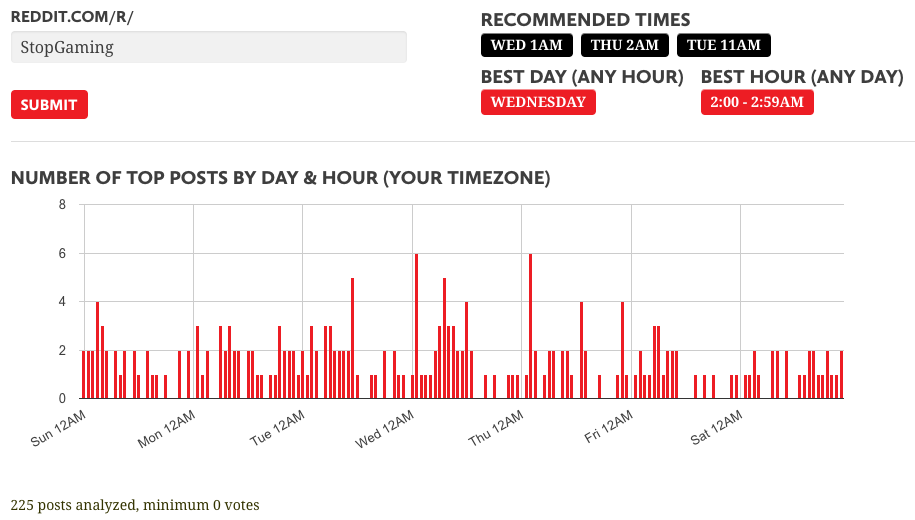
You can do it by checking what day and time are best to submit content to Reddit. SiegeMedia’s creative Reddit tool allows you to do that and make sure you maximize that micro effort of submitting a post to the platform.
9. IMPROVE CONTENT WITH NEW RANKING KEYWORDS
If you’re producing content that caters directly to the main topic, you’ve got chances of receiving other ranking opportunities for relevant keywords (within the same topic theme), aside from dominating your main keyword.
If you can find other keywords that are likely to give you a boost in organic search visibility, you are increasing your brand equity on main industry topics.
SEMRush allows you to find already ranking keywords of your page, as well as of your competitors, and see what they are up to (giving you an insight as to how you can better improve your own content by adding sections (subsections) to target relevant long-tail terms.
10. ENGAGE READERS WITH STOCK VISUALS
In this design-heavy generation, using stock photos is imperative to appeal to your target readers. The lazy common way of adding non-stock photos you’ve searched for in Google (worse if they’re copyrighted and can’t be reused) will do more harm than good for your content.
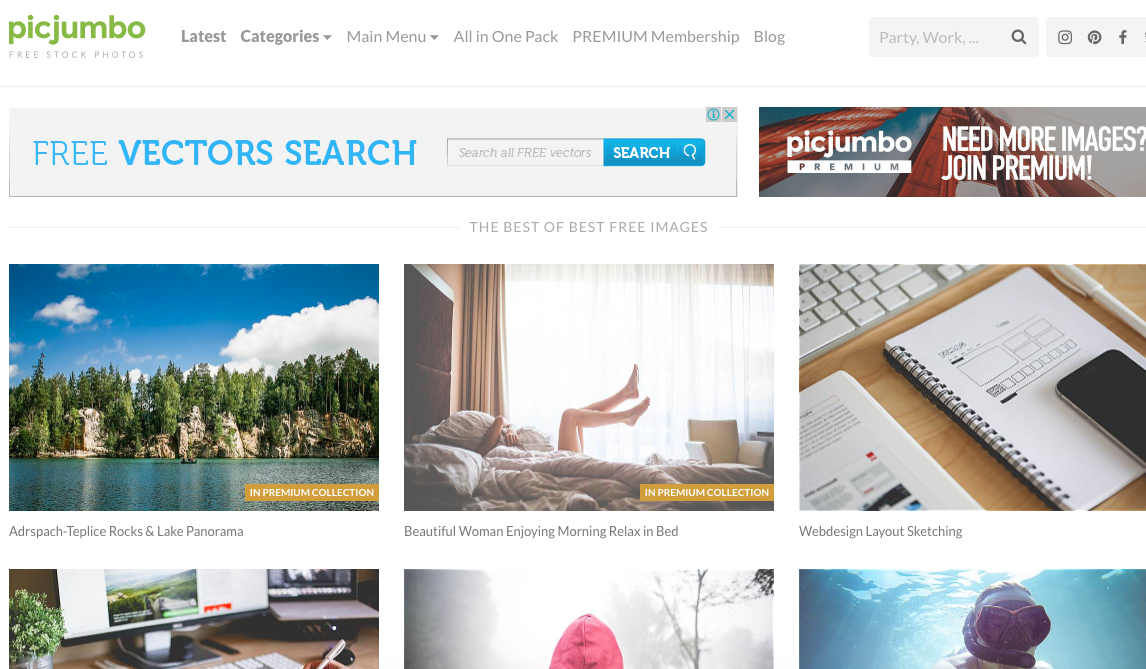
The truth is, you won’t get additional traffic simply by adding stock photos (even designing it well if you have the audacity to do so), but letting your current visitors stay on your site allows you to acquire indirect benefits of additional social shares because the overall content is good. This translates to more targeted referral traffic.
I’ve been using the following sites to get stock photos and design them by myself thru Canva:
It only takes five minutes to have a well-designed featured image for one blog post.
Tip: Use the search tool function of Google to filter searched images that don’t have any copyright issues (to ensure you’re not passing over to one’s property).
11. CONNECT TO INSTAGRAM INFLUENCERS
The power of Instagram to absorb new followers is insanely useful in this age where we can create micro-content every day.
Besides using 10 to 15 hashtags in the description of your photo, you can also tap the power of influencers to provide you with enough discovery for your brand/content.

DM’ing people to build relationships and offer substantial value to let your brand be discovered on their Instagram profiles allows you to get social traffic straight to your profile and/or to your website.
12. DISTRIBUTE CONTENT TO YOUR EMAIL LIST
I’ve seen a lot of micro-content performing well on distribution nowadays since the more companies whether in B2B or B2C are publishing content on a daily basis, the higher the competition there is to consumers’ attention.
If you’re strategic enough with your content, you can maximize your own email list asset to drive consistent traffic to your website.
Though marketers ruin the email marketing platform with so many self-promotion ads, there’s still room for engagement and direct traffic we can get from email alone.

Maximize your email distribution by providing enough value to them on a regular basis. Build brand equity over time.
You may want to test out this email tester tool to improve your emails' subject lines.
13. MAKE 11X CONTENT WITH ADDITIONAL CONTENT FORMATS
10x content has been a common term in the marketing space today. While this could be the era where a lot of publishers are producing long-form content, there would still be a few who don’t see much results from their efforts.
Long-form doesn’t mean depth of content. Even if you created a 10,000 words guide that others in your niche have also done, but if users are staying enough to consume your content (check your site’s time on page), you still lack value.
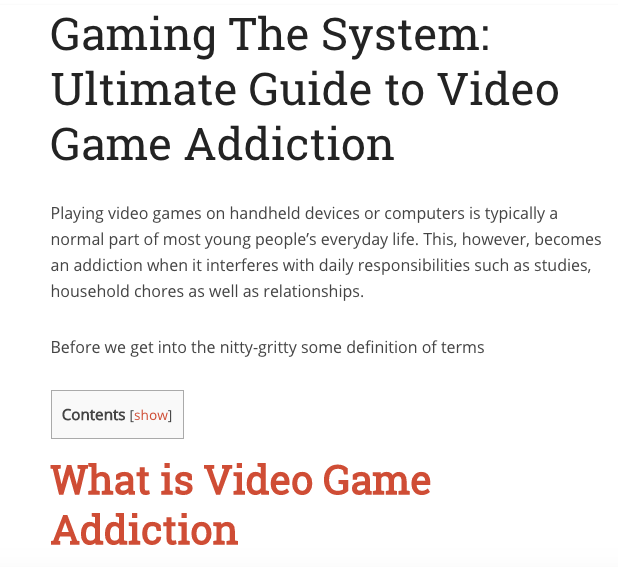
One way to better engage your users in your content is to add other content formats to make it interactive. Images, videos, slides, and other media formats that are relevant and cater to the same topic you’re discussing shouldn’t be hesitated to add to your content.
14. INCREASE SOCIAL REACH WITH PINTEREST
If you’re in the mommy/parenting/health space, there’s a huge opportunity waiting for you in the Pinterest platform.
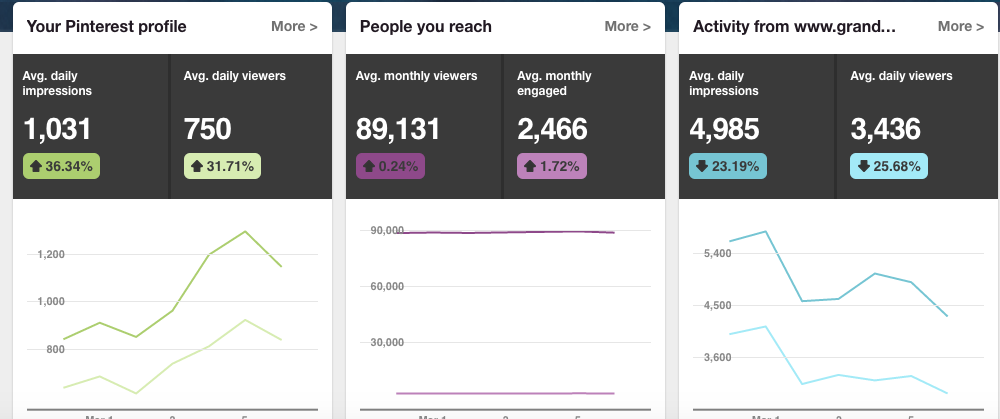
If you practice it right, you can see engaged visitors on Pinterest that can go to your website and start following you.
You can check your top Pin post impressions and find the common topic theme that you can start focusing on in a certain period of time (let’s say for a week). This gives you more room for organic reach opportunities that’ll eventually drive good social traffic to your website.
15. SCALE CONTENT CREATION WITH CONTENT TEMPLATES
If you’re handling several accounts, whether you’re in an agency or an affiliate marketer with many niche websites, you may be having difficulty in scaling your content creation process.
The truth is there’s an easy way to scale the process simply by utilizing content templates (common content formats that have been successful in engaging consumers/users).
You can check out this post by Ross Hudgens on 15 content templates that you can use to successfully produce content in a scalable manner.
16. HACK UPVOTES IN REDDIT
Building your own tribe of content promoters who are ready to push your content up on specific platforms gives you the luxury to get initial traction for your content.
Though in most cases, you’ll see this happening in the marketing space, other industries are also leveraging this strategy to build mutual value exchange with each other (using each profiles’ social followers to promote mutual content).
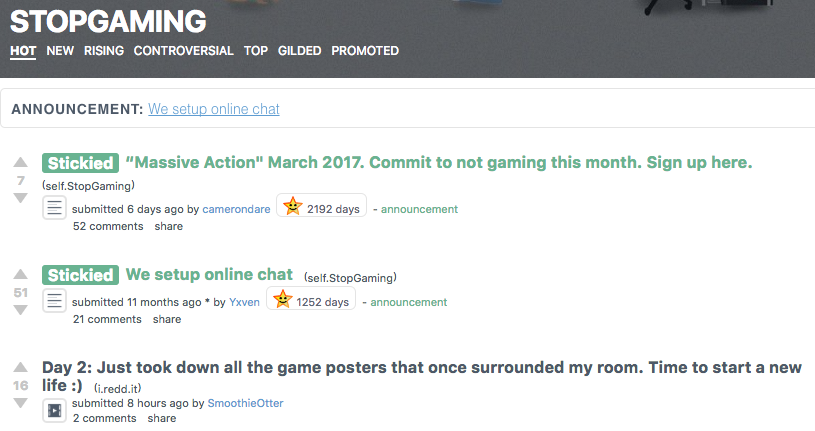
This requires the execution of reaching out to other industry bloggers who aren’t competing with your offerings. Always provide value here as you don’t want to look like an aggressive marketer trying to leverage others’ ability to promote content pieces.
17. DOMINATE WITH QUORA
Building your brand (whether on a personal or business level) is executable in Quora. Like other Q&A sites, your goal is to answer relevant questions that received a substantial amount of views every week/month. This allows you to scale the process, as you are able to grow your profile answer views over time, particularly if the topic is most commonly asked for in Quora.
Check the question’s potential reach by looking at the number of followers for that specific question and the top or even the average number of views of the top answer. This would give you an idea of whether the question is worthy of your effort to answer.
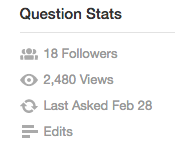
You can also check if the exact question is sitting on the first page of search results when you directly copy and paste it to SERPs. In most cases, this type of question is consistently attracting new visitors, thus, helps you answer to increase its potential reach.
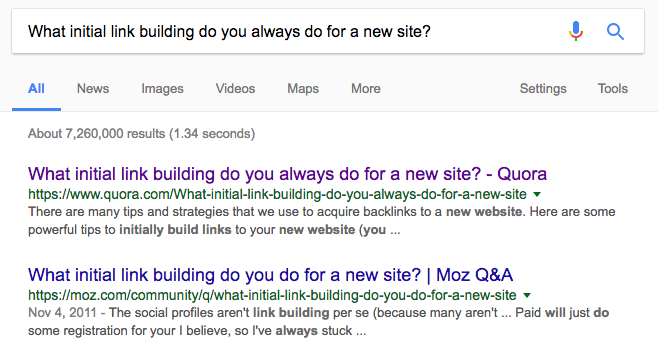
Execute this process daily (choose 3 to 5 recent questions) and become the top industry writer in Quora.
18. SWITCH YOUR CONTENT TO A NEW HIGH-VOLUME KEYWORD
David McSweeney of Ahrefs had a case study on how they were able to increase the blog’s traffic by switching keywords to old-performing content.
The process is simple:
- Analyze existing keywords of the content you’re currently been ranking for.
- If you haven’t seen any main keywords you can potentially switch to potential ranking, conduct keyword research to find out if there are main phrases with higher search volume than your current one.
- Optimize your content for new keywords by changing the page’s URL, meta title, and other on-page factors.
- Setup a 301 redirect of your old URL to your new URL (this is extremely important).
- Use Fetch to Google in Console to force Google to crawl the page.
This works effectively if you’ve got pages that aren’t performing well in search and be instead switch to other relevant keywords that have a high organic search count.
19. DO REVERSE GUEST POSTING STRATEGY
If you truly want to maximize your time to acquire high-quality backlinks to your site, you should look for ways to scale the link building process.
One powerful method to build links that require no outreach and that attract potential linkers to your website is to do a reverse guest posting strategy.
It’s the counter tactic of the common guest blogging technique that allows you to receive pitches from potential guest bloggers.
To start with, you can create a “write for us” industry page that contains the following formats:
- Guest blogging guidelines
- Industry topic themes accepted
- Sample approved guest posts (if you have accepted guest articles in the past)
Once done, build internal links to this page by linking to it from your other blog pages. This allows you to bump up the page’s organic rankings. The goal is to dominate the industry key phrase “industry write for us” or industry guest post”. This will then open opportunities to receive guest blogging pitches.
Interact with industry bloggers who pitch you for guest posts and see how you can maximize this opportunity. You can then offer mutual benefits, such as accepting his/her high-quality article to be published on the site while being a guest on his podcast show, if he occasionally does it.
Another value proposition that you can offer is to build a backlink to your other relevant website (Site C) from the guest blogger’s site.
Here’s the scenario: Guest blog (Site B) acquires a backlink from your first site (Site A) through a guest post. You offer to get a backlink from his site (Site B) to your other relevant blog (Site C).
This better works if you have two websites that are thematically relevant to each other (e.g. same health industry).
20. TAKE ADVANTAGE OF QUORA/PINTEREST RANKING PAGES
Top of the funnel keywords with low competition is goldmine opportunities. One way to find them is to use SEMRush to generate industry keywords where Quora and Pinterest pages are ranking in their search results.
Given that these pages of Quora and Pinterest dominate the search, you have the potential to rank on the first page if you’ve created good content to service the search users for that topic.
To start with, plugin quora.com and pinterest.com to SEMRush and search the industry/topic theme of your site in the search bar. This will reveal keywords you can potentially target to rank for your brand.
For example, the keyphrase “youtube addiction” has a good amount of search volume but a Quora page is ranking on the first top-five spots (as of date..).
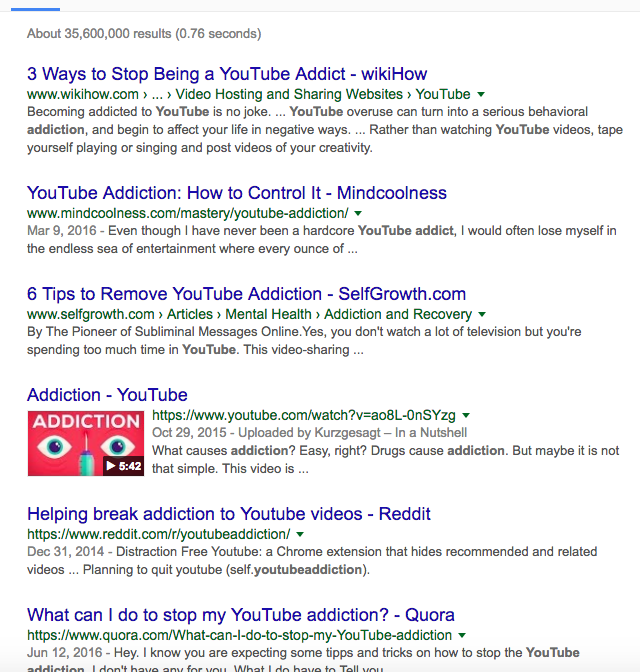
If you’re in a counter-addiction space, this is one of the keywords that can give you some good traffic every month.
21. LEVERAGE BIZDEV PARTNERSHIPS IN EMAIL MARKETING
Targeted email newsletters are powerful sources of referral traffic that you can take advantage of in your space.
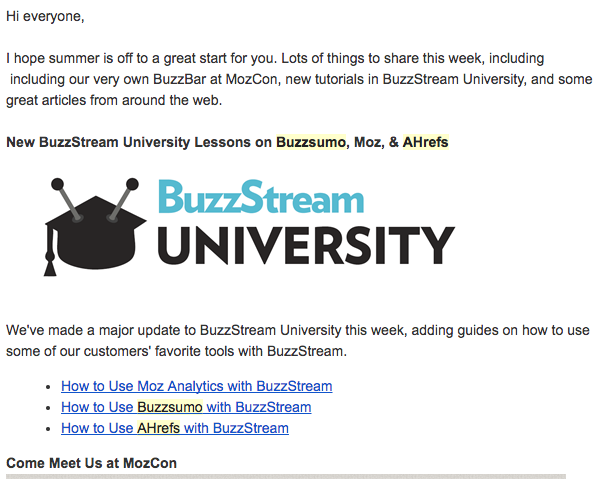
If you have established authority in your niche, you may want to maximize opportunities of getting in touch with bloggers who had a substantial email following, particularly those with high potential of linking out to relevant external blogs (e.g. regular round-ups).
A simple outreach of proposing an exchange value (interviewing the blogger on your blog while getting featured on his/her email release next week) can increase the probability of success of this marketing tactic.
Your Turn…
Do you have other ways to drive traffic to your website?
Leave a quick comment below.
I’ll be more than happy to reply to comments and answer questions.
Why and How Influencer Outreach Works
What is influencer outreach?
Influencer outreach is a marketing discipline of identifying influencers in an industry, qualifying them based on relevance, clout, and engagement, and pursuing them by adding value to what they do.
It is a common practice in different outreach campaigns. The only difference is that you are reaching out to an influencer.
What is an influencer?
An influencer is an entity or a person with a massive reach (social, web or offline), who also serves your potential customers with content in their preferred platform.
When influencers endorse an offering from your site or a content asset you recently produce, you gain reach from their existing fanbase. You also have the chance of absorbing their followers if they've found your content useful to them - which is the primary win for any brand that engages in influencer outreach.
Besides that, there are many other benefits a brand can get aside from the absorption of their current following.
Value of Association
Trust is a glue and attractive force that makes people want to buy from you. It's common sense that when a trusted person or entity endorses what you offer to the market, it's possible that potential customers trust you more.
When you do influencer outreach, you actually take the risk of associating yourself with the influencer you're targeting. That's the reason why it's critically important to qualify influencers whom you would consider in a partnership.
The moment they introduce any of your page or content piece, you're letting them associate with yourself.
If the influencer has a good reputation and doesn't simply endorse any site/content, you're putting yourself in a respected position.
Though the influencer has limits as to when and how they would co-promote your offering/content, the value of association is priceless as it gives more authority and trust to your brand.
Content Marketing Opportunities
You never know how far your content will be able to reach once it's been part of the influencers' circle of content.
You might have a chance to get opportunities not only from the direct exposure of the influencer, but potential ones its (influencer's) followers might provide for you.
Future collaboration can take place when that happens.
While many marketers discuss virality as a guaranteed mark of a successful campaign, there still isn't a perfect formula to make content go viral.
With influencer outreach, you're increasing the probability of your content being more visible, rather than just guaranteeing its virality (though that might happen as well). The truth is virality comes from higher visibility of your content in different places.
Influencer outreach does that for you. It helps you increase your content's visibility in your target audience.
HOW TO DO INFLUENCER OUTREACH
There are many techniques you can find in several articles on this topic, but there are common initiatives you must be able to learn and execute well to effectively get results from this type of campaign.
I. SETTING YOUR CAMPAIGN'S GOALS
This is common sense, but I find marketers jump into outreach very quick without even knowing why they are reaching out to influencers in the first place
What is your goal? What are you trying to achieve in your partnership with the influencer? Is it to get a mention in one of his blogs with a contextual link to your site/page? Do you want exposure in his non-text content (podcast or Youtube vlog)? Do you want to collaborate for a solid content piece that can dominate a keyphrase with high search volume?
Go deeper into asking the purpose of your campaign. Get a piece of paper and write it down.
II. IDENTIFYING INFLUENCERS
This initiative is the first activity among all influencer outreach campaigns.
Next to knowing your goals, you discover who you are reaching out to. And this is the part where campaigns will vary.
There are tools to help you semi-automate the process of discovering influencers in your industry. Let's discuss a few of them.
A. Google Search
The basic methodology of discovering potential influencers for collaboration is by doing Google search.
Use any of these queries to find influencers in your space:
- "top bloggers" INDUSTRY
- "author" site:TOPINDUSTRYBLOG
- "top influencers" INDUSTRY
You can also discover influencers who are contributors to a blog in your industry. See the search query I used below.
B. Ahrefs Content Explorer
Not only that you'll be able to find the most popular articles in your niche using Ahrefs' Content Explorer. You can also locate influencers who have tweeted those top content pieces.
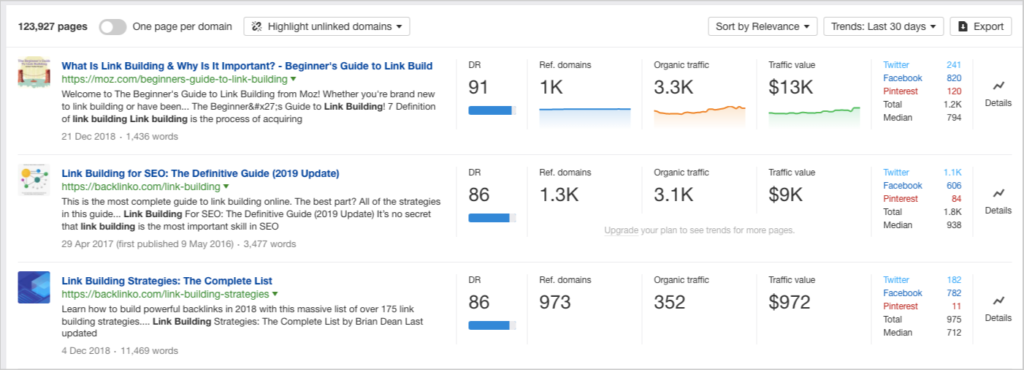
After searching for the topic of your choice, you will see a list of the top pages for that topic. For each content piece, there is an available Details button which you can click on to see more information about the article.
Click on "Who Tweeted" and there you'll have a list of influencers who have tweeted the article.
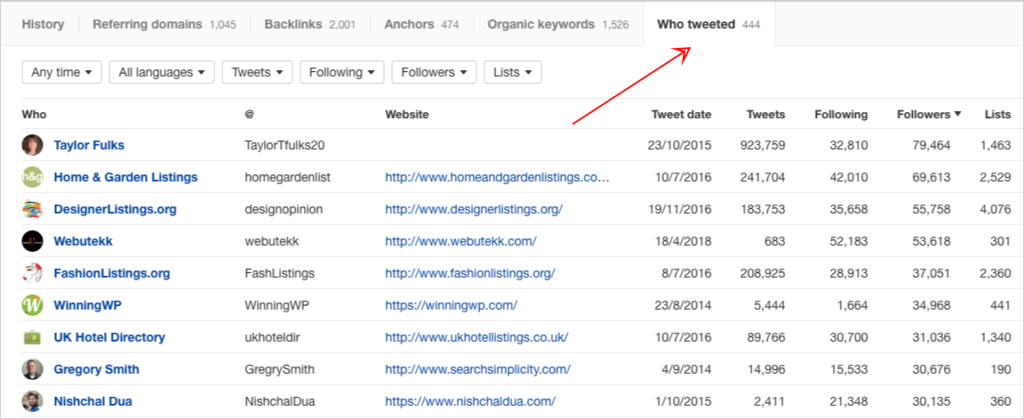
You can filter the list based on the recency of their tweets, the language they speak of, and the number of following/followers. Export it into a file for later use.
C. Buzzsumo
One of the most useful web-based products for influencer discovery is Buzzsumo. Its Influencers feature allows proper filtering.
You can filter the list by the type of influencers that you want to engage with: bloggers, influencers, companies, journalists, or regular people. This refining keeps your campaign more targeted to a specific group of influencers.
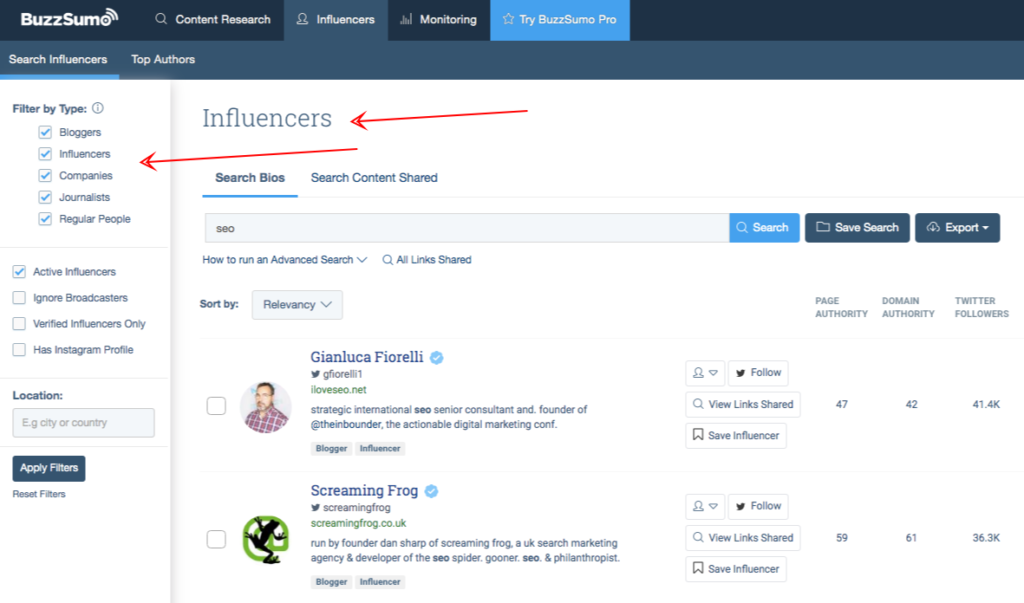
For local influencer outreach campaigns, you can filter influencers based on location.
Buzzsumo gives you options to sort the list of influencers from highest to lowest following Klout, retweet or reply ratio, and average tweets.
Maximize the use of those three tools: Google search, Ahrefs' Content Explorer, and Buzzsumo in order to make a solid list of influencers for your content marketing campaign.
After setting goals for your influencer outreach campaign and discovering suitable influencers, your next activity is to think of a strategy that makes the content more valuable for both parties - I call this valued partnership.
III. CONTENT PARTNERSHIP
You will not send emails to your target influencers without thinking of the value that you'll provide for them. With several priorities they have, they only respond to emails that are worth their time.
One value you can provide to them is content that both of you will benefit from.
Here are some examples of effective content partnerships you can consider to your campaign:
A. Twitter Chats
Twitter isn't only a place for ranting complaints, but a good platform for learning conversations.
For example, there are brands in the digital marketing industry that regularly hosts Twitter chats where they invite special guests (agency owners and consultants) to join their discussions for topics they specialize in.
If you have a substantial number of followers in your Twitter account, you can use Twitter chats as a value proposition in your influencer outreach pitches.
Invite influencers to join your weekly discussions.
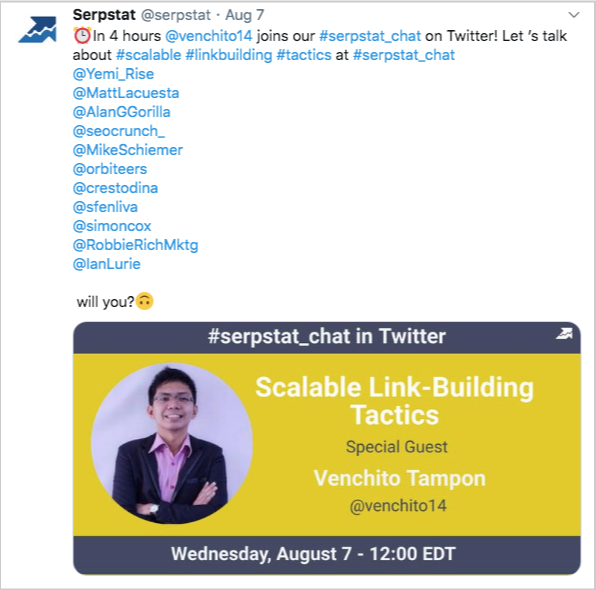
It's important to have a solid strategy for Twitter chats, and not just make it an ordinary discussion. One way to maximize it is to prepare questions related to the influencer's expertise. This would allow a more fruitful discussion with the community.
B. Video and Blog Interviews
Creating more useful content than what others have previously produced is now a challenge for content publishers. With much data and information published every day, a content piece must have a non-generic message people would actually consume at their best capacity.
This problem leads to content fatigue. It happens where there are excessive production and data of content that makes people become less and less receptive to the message that the brand is trying to send to its audience.
The solution to this problem is to collaborate with influencers for a solid content piece both parties will benefit from.
By doing influencer outreach campaigns, you can hit two birds with one stone-- engage an influencer while at the same time providing unique content to your target audience.
Produce an interview-type of content where both parties are able to discuss different yet thematically-relevant subjects.
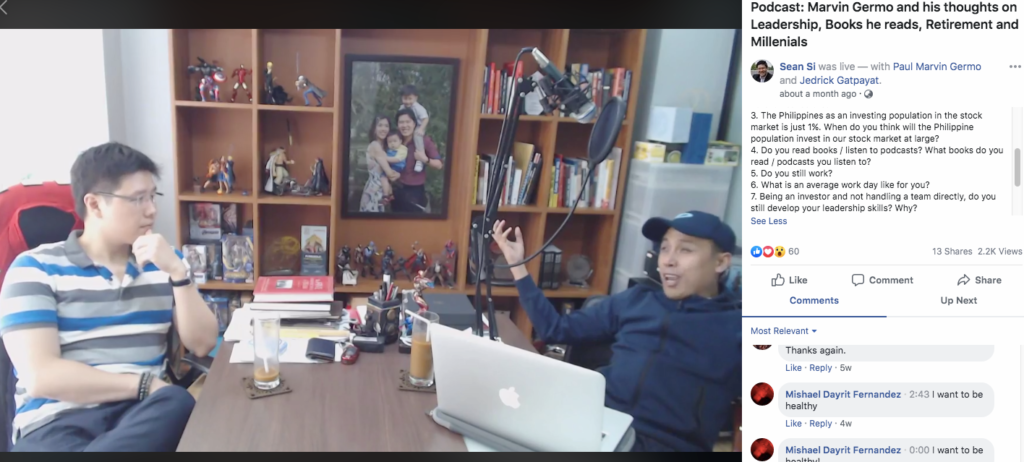
By doing so, both parties may absorb followers (subscribers) from each other.
C. Free Accounts
SaaS companies provide free accounts of their web-based products to publishers and influencers. While this should be an easy strategy for some, I've seen SaAs brands fail to get buy-ins from influencers to use and promote their products to their followers. One of the reasons why it happens is because they don't emphasize the value of their products.
The key in crafting your email pitches to influencers is to understand what makes your SaAs tool different from its contemporaries. There may be just 1 or 2 features that you need to highlight and focus on in your pitch.
D. Facebook ReShares
Facebook is a great platform to absorb followers from different asset pages. If it's done well, you can gain a massive following in a short period of time.
One of the effective techniques I absorbed in the past years that worked really well in increasing the visibility of a brand page is collaborating with other pages that target your audience.

By developing partnerships through content supported by both entities, you'll be benefiting from each other’s additional organic visibility and increase of influence and authority in your niche.
IV. MORE INFLUENCER OUTREACH TECHNIQUES
Content is definitely a valuable asset that you can offer to influencers. However, getting your pitches into their hands will require some additional techniques.
These influencers are getting several emails every day, so you have to make sure you do the necessary methods to get in front of their inbox.
A. Start with small-scale interaction
The ideal scenario is to pursue A-list personalities, but reality-wise, if your brand isn't well known and isn't that authoritative, the best recommendation is to start with a small-scale set of influencers.
As you develop relationships with low-tier to mid-tier personalities, you'll realize they would open more doors of opportunities for you - connections with other levels of influencers or a higher-tier network of friends they know.
That process allows you to step by step build your own networks of influencers. It surely takes time, but the methodology of small scale interaction gives you leverage over a wide variety of connections.
B. Do pre-outreach engagement
Learn to know more about your influencers. It's not enough to quickly pitch them with your products or content piece.
If they haven't seen you in their circles, they're likely to ignore your outreach email.
It's very basic, but one of the best ways to increase the effectiveness of your campaign is to engage with them before pitching.
Share what they've posted on Twitter - a retweet with a comment that actually reads the article they wrote.
A sign up to their webinar or email newsletter to get to know what they're up to - the interests and the value they're looking for.
Craft your emails in a way that it attends to your prospect's interests and needs. If you can write emails from scratch without any template, this will help hone your influencer outreach skills.
IDENTIFICATION BEFORE PERSONALIZATION
You can't personalize your email pitches without identifying interests and needs you have to provide to your prospect influencers. Do due diligence to profile them intently so you can write emails that best give value and not just want to get something from them.
Strategy for Follow-Up Emails to Link Prospects
In this blog, I've covered a lot of topics pertaining to outreach, from pitching bloggers, finding contacts' email addresses to making tweaks to certain outreach facets to increase response rates.
But one that I haven't discussed yet is on the subject of follow-ups.
There are four realities that I can base on my experiences about the importance of sending follow-up emails.
First, follow-up emails may remind non-respondent contacts about what they've missed in the initial pitches you've sent them. They may read the entire message, but have forgotten to respond unless they've had follow-up tools like Followup.cc and Boomerang to remind them to reply.
In reality, not all links you'll be building every month will be generated from your initial pitches. At most and you should base it on your own testing, you'll find that a huge percentage of your links may come from your follow-up emails. This speaks of the second important reason for such activity.
Failure to follow-up initial non-respondents is a missed opportunity to get the desired links.
Lastly, follow-up emails may speak of your persistence in sending value-driven messages to your contacts. However, doing so aggressively may affect how your site/brand may be perceived to be offering value whether in a form of content submission, collaboration, or any potential brand equity.
There are a few points I have to make in this post and may spark some ideas for you to A/B test and see which option may work for you.
1. New email with the original message or email sent as a reply to the initial pitch
There isn't any better email practice between these two options. One has more advantages than the other, and vice versa.
When you send new emails with the original message, you may recoup what has been an error in the first email. Strictly check why it hasn't been sent in the first place - it may be an erroneous input from your end - such that, a wrong email address. Receiving a bounced email for the second time is a clue to that.
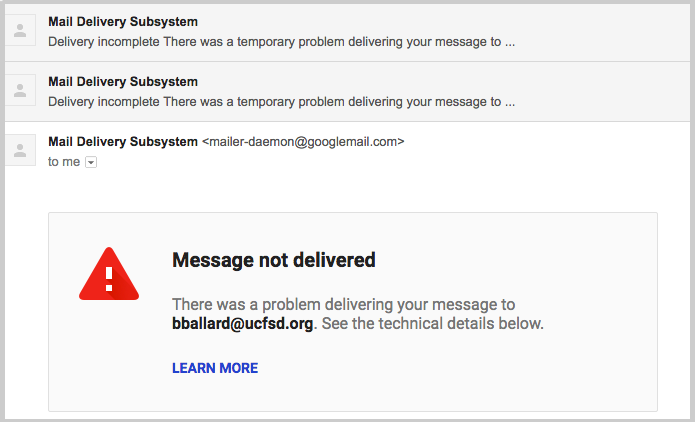
Sending new emails can also give you the luxury of trying another email subject line that may at this time, capture the eye of the recipient and can get your email to be opened.
Follow-up emails sent as a reply to the initial pitch can best work if the original message has been opened and read, given that it'll also have a chance to be opened and read as well.
One drawback from that is that the recipient might have to click on … to see the previous message, which may add friction to the conversation.

Both of the options: new email with the original message and email sent as a reply to the initial pitch may work in different circumstances. There are many variables that may come into play for follow-ups, but can be an interesting item to A/B test against to see which option is significantly more effective than the other.
2. Channel non-respondents with social accounts
In general, there are three ways on how to approach outreach with social accounts like Twitter.
First, ask for the contact's personal/direct email address. It'd be easy to engage in conversations when the email is valid and is directly accessible by your contact. This will help avoid back-and-forth emails as to who you should reach out to for a certain matter - the inclusion of a link request on one of their pages, for example.
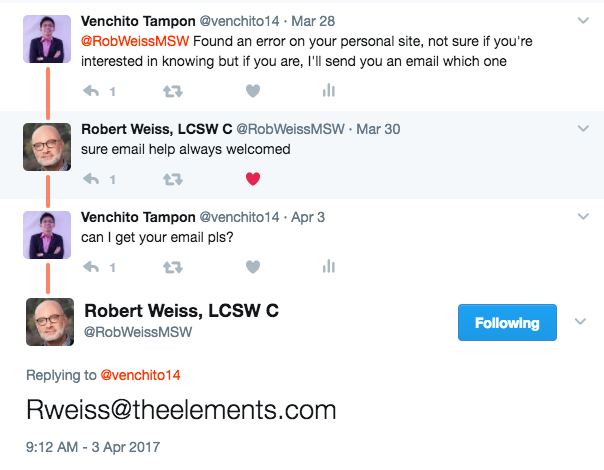
I've covered this outreach technique in my post about building contextual links - you may want to check that out.
The second is to directly pitch your contact using Twitter after several outreach attempts with no replies. Unlike the first approach where you'll get the contact's email address and channel it back to your email conversations for engagement, what you'll need here is basically identifying the Twitter profile and pitching your message straight.
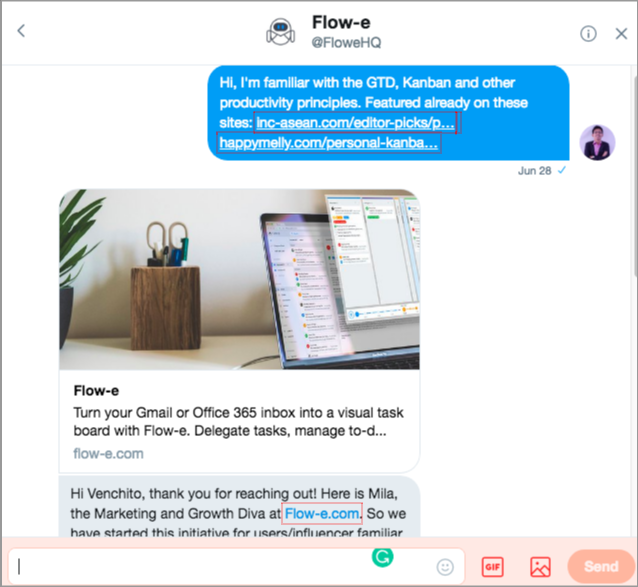
The third approach requires a considerable amount of time to get some returns. If you have sourced your contact from Twitter, either you've seen him being recommended as a top contributor in your niche or have siphoned him from a public Twitter list of bloggers or influencers.
Let your contacts know where you've found them by using lines such as, "I saw you as a recommended blogger follow on Twitter and wanted to follow" instead of "I'd like to make a follow-up" - which is useless to say.
3. Following up on engaged link prospects
There's a natural tendency to follow-up link prospects when they haven't responded yet, or just waiting for a confirmation of a link acquired or content being submitted for review.
If you're reaching out to people who've previously linked to similar content pieces (e.g. resource page curators), the basic recommendation is to not give them any instructions, since they're natural linkers. In the first place, they usually know what to do next - either to link or share your content, which really depends on how useful your content is to them or to their audience.
So, in what scenarios would you send a follow-up email to an engaged link prospect?
For guest contribution, a follow-up email to an editor who's been reviewing your content for a while but hasn't responded yet is worth considering, for reason that they may have almost forgotten to review your content or they made it into a final draft, but haven't notified you.
Just make sure to keep your follow-up email short and to the point. No need to overload them with information you've already given them; just give them a reminder and get the conversation going again.
There is no particular set of rules here, but as you go through conversations, you'll be able to find the right timing to follow-up link prospects and to identify which contact person needs follow-up or not.
Need help with your outreach campaigns? Check out our link building services here.
How to Get Featured in Link Roundups
What are link roundups?
Link roundups are curated content of the recent and most outstanding content of industry publishers and content creators published either daily, weekly, monthly, or annually.
Here are a few examples of links we’ve got for Digital Philippines (my own link building blog):
- http://www.pageonepower.com/linkarati/linkarati-roundup-48
- http://www.highrankwebsites.com/article-roundup-my-favorite-posts-in-internet-marketing-this-week/
- http://seocopywriting.com/seo-content-marketing-roundup-week-ending-may-22nd/
- http://citationlabs.com/link-building-seo-roundup-fall-2014/
Why get a link from a link roundup?
Active searching
Unlike any other content creator whom you will pitch for link inclusion, link roundup creators are actively looking for great content to include in their regular list.
It’s hard to consistently produce link roundups in your niche as you have to actively find the latest and valuable content from bloggers, otherwise, visitors of regular link roundups won’t come back.
In this case, you are actually initiating the favor for them. By giving your own great content, you’re helping them to find the best posts in your industry.
Recurring links
What I liked about link roundups is that once you’ve established relationships with these content curators, you could get consistent recurring links from them. This consistency obviously depends on the quality of content produced by your brand.
Your potential links won’t end there. When industry publishers find your content in one particular link roundup that might be an additional link on your end when they start to reference yours in their own content marketing.
First burst of links to get your site
If you’re mainly targeting long-tail keywords or a non-competitive keyphrase, those first sets of backlinks you’ve acquired from link roundups can help you reach the second page or even the first page of search results. These may lead you to earn more links from industry researchers on your topic.
How to prospect for bloggers who publish link roundups?
There are three easy ways to find link roundups in your niche or in a thematically relevant industry.
1. Use Twitter to find link roundups
Twitter is one of the underestimated search tools when looking for regular link roundup curators. With a quick search on link roundup queries, you’ll get a handful of bloggers curating full-links content like this one.
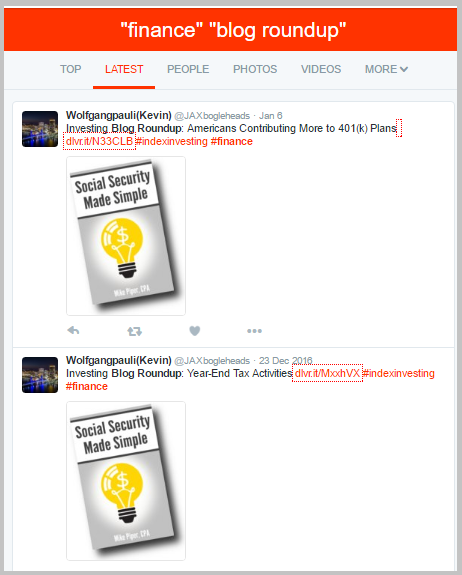
2. Google search queries
Besides Twitter, you’ll obviously get tons of results from search engines themselves.
Go to your favorite search engine and use any of the following search queries
- “KEYWORD” "best blog posts"
- “KEYWORD” "best blog updates"
- “KEYWORD” "best blogs updates"
- “KEYWORD” "best pieces of content"
- “KEYWORD” "best posts of the month"
- “KEYWORD” "best posts of the week"
- “KEYWORD” "best posts this week"
- “KEYWORD” "daily link round up"
- "KEYWORD” “daily round up"
- “KEYWORD” "favorite posts of the month
- “KEYWORD” "favorite posts of the week"
- “KEYWORD” "friday link round up"
- “KEYWORD” "friday round up"
- “KEYWORD” "monday link round up"
- “KEYWORD” "monday round up"
- “KEYWORD” "monthly link round up"
- “KEYWORD” "monthly round up"
- “KEYWORD” "notable posts"
- “KEYWORD” "notable updates"
- “KEYWORD” "posts of the month"
- “KEYWORD” "posts of the week"
- “KEYWORD” "round up"
- “KEYWORD” "roundup"
- “KEYWORD” "saturday link round up"
- “KEYWORD” "saturday round up"
- “KEYWORD” "sunday link round up"
- “KEYWORD” "sunday round up"
- “KEYWORD” "thursday link round up"
- “KEYWORD” "thursday round up"
- “KEYWORD” "top posts of the day"
- “KEYWORD” "top posts of the month"
- “KEYWORD” "top posts of the week"
- “KEYWORD” "top posts of the year"
- “KEYWORD” "tuesday link round up"
- “KEYWORD” "tuesday round up"
- “KEYWORD” "wednesday link round up"
- “KEYWORD” "wednesday round up"
- “KEYWORD” "weekly link round up"
- “KEYWORD” "weekly round up"
- “KEYWORD” best blog posts
- “KEYWORD” best blog updates
- “KEYWORD” best blogs updates
- “KEYWORD” best pieces of content
- “KEYWORD” best posts of the month
- “KEYWORD” best posts of the week
- “KEYWORD” best posts this week
- “KEYWORD” daily link round up
- “KEYWORD” daily round up
- “KEYWORD” favorite posts of the month
- “KEYWORD” favorite posts of the week
- “KEYWORD” friday link round up
- “KEYWORD” friday round up
- “KEYWORD” monday link round up
- “KEYWORD” monday round up
- “KEYWORD” monthly link round up
- “KEYWORD” monthly round up
- “KEYWORD” notable posts
- “KEYWORD” notable updates
- “KEYWORD” posts of the month
- “KEYWORD” posts of the week
- “KEYWORD” round up
- “KEYWORD” roundup
- “KEYWORD” saturday link round up
- “KEYWORD” saturday round up
- “KEYWORD” sunday link round up
- “KEYWORD” sunday round up
- “KEYWORD” thursday link round up
- “KEYWORD” thursday round up
- “KEYWORD” top posts of the day
- “KEYWORD” top posts of the month
- “KEYWORD” top posts of the week
- “KEYWORD” top posts of the year
- “KEYWORD” tuesday link round up
- “KEYWORD” tuesday round up
- “KEYWORD” wednesday link round up
- “KEYWORD” wednesday round up
- “KEYWORD” weekly link round up
- “KEYWORD” weekly round up
More link building search queries: Search Engine Queries Cheatsheet
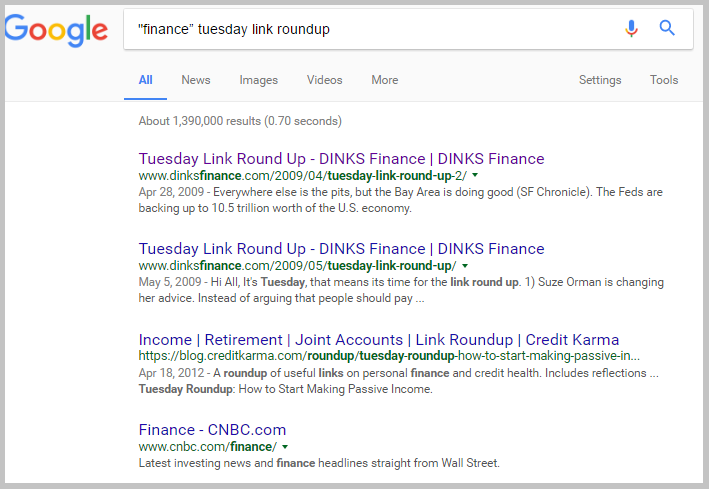
Qualify them based on a number of things and put “industry link roundups” to your spreadsheet (head over to “how to quality link roundups” section of this post).
3. Reverse engineer top industry blogs
If you’re trying to search for more link roundup curators in your space, try scraping top blogs and see their latest backlinks.
Hand a top industry blog’s URL over to Ahrefs.
See their newest backlinks by going to the Backlinks section and clicking “New” (see image below).
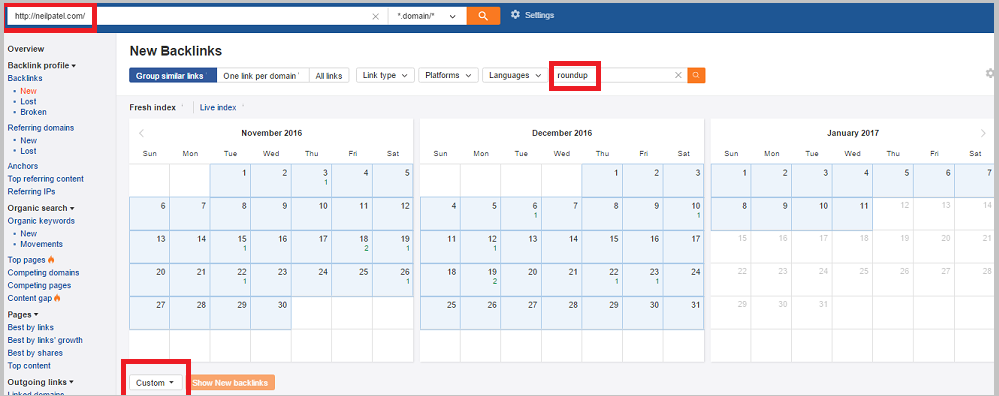
You can customize the time period so you can see more results in the backlinks section. For example, I’d try to click on November 1 then on January 11 (which is the current date today). This way, I’ll be able to see results of recent backlinks of Neil Patel’s blog for the past 3 (almost) months from November 1 to January 11.
To find the goldmine link roundups in the newest backlinks section, simply type “roundup” or “best” (for “best of the day” or “best of the week”) in the search function to filter only recent backlinks with “roundup” in its title or URL.
Once you do that, you’ll get to see a couple of link roundup curators that you wouldn’t just find simply through Google search or Twitter function.
A couple of examples of link roundups I came across on Neil Patel’s recent backlinks.
- https://thewebatom.net/blog/november-webmaster-resources-roundup/
- http://dkspeaks.com/weekly-link-roundup-content-promotion/
How to qualify link roundups?
I highly recommend that you qualify link roundups as you go searching for them. This way you’ll incorporate to your list of blogs (on a spreadsheet) ONLY qualified link roundups.
Here are my qualifiers for link roundups?
External not internal links
Include in your spreadsheet link roundups that point to external links (or at least half of the links should be external). Don’t bother to outreach someone that curates his/her own resources alone.
Informational content, not products
Your VA or a link builder might include every link roundup in your space. But not all of them will be useful for your link building campaign. Those link roundups with all items and products listed aren’t a good use for outreach – you won’t acquire a backlink from them unless you promote a product yourself.
Frequency of link roundups
Not all link roundups are usually curated regularly, other industry blogs stopped doing so. Make sure each link roundup you’ve listed has the most recent link roundup on their blog (if it’s weekly, make sure they’ve posted a full-link content a week ago).
If you’ve found one old link roundup (e.g. “best of posts” “industry” September 2016), check it on Google and change the “all time” search function to past week/month (depending on the frequency of the link roundup).
See if there are results that pop up which show that they still curate the best articles and blog posts in your niche.
How to organize link roundup spreadsheet?
Documentation is key to scaling this link building process to all of your clients. Though it’s no guarantee that this link roundup strategy can be used for any verticals, having a list of industry full-link content can help you easily acquire links for a new client in the same industry as your other ones.
No rocket science when organizing a link roundup spreadsheet. The only details you need are:
- Domain name
- Roundup URL / Sample link roundup (that’s the reason you have to find the most recent link roundup of the publisher)
- Roundup label/name (add their weird titles – i.e. “blog hop”, “link party – which may look at blackhats, but it’s just the name.
- Frequency (monthly/weekly/yearly)
- Blogger’s name
- Email / Contact form
- Contact form (if the email is not available)
- Relationship status
*Read further for finding contact information tips.
How to pitch to link roundup curators?
Pitching to link roundup curators is no different from other outreach campaigns: finding contact information, customization, and other factors that would make your emails get opens and responses.
Let’s first gather contact information. A few tips to find it:
- Check if the author bio has its name (or for most brands, it’s just “admin”). Then go directly to about us/team us (if it’s a company-looking site), then look for the direct email of the person.
- If it’s purely a blog, see the about page. If you can’t find it, subscribe to his/her blog, the email that he uses to send email updates are likely the same email he used for communication. Paste that contact info into your spreadsheet.
- If email is not available, copy and paste the contact form of the website (you’ll still have a high chance of getting responses though).
A few other places where you can find contact details if they’re not in the about/contact pages:
- Privacy policy
- Disclaimer/disclosure page
- Social media pages (Facebook/Google+/Twitter)
- Google queries (“name” + “email” OR ‘contact”) or (site:[domain.suffix] + “email” OR “contact”) or (domain.suffix + name + email)
Tools to find direct emails:
Further reading: How to Find Any Email Address: Seeking Email Superheroes
After you’ve completed contact information in your spreadsheet, you’re now ready for outreach.
You can use this exact email template below or have your own but make sure you follow these quick tips:
- Make your subject line straightforward (it could be too content pushy if you just include “consider this content in your next link roundup” or any similar subject lines). See the subject line below.
- Personalize by greeting the blogger’s name.
- Include the “link roundup label” in your pitch (a few bloggers have tens of link roundups on their blogs, especially if they’re a content curator). Make it easy for them to understand your pitch by stating which “link roundup” you’re looking to get placement with.
- Your content is key here. If your content is fluff, even if you push it to hundreds of bloggers, you won’t get as much links as you expect. Ensure your resource has unexpected hooks and had in-depth information on the topic.
Subject: Content for [LINK ROUNDUP TITLE]
Hi Helen,
I saw that you're doing a [FREQUENCY] round-up post on [BLOG NAME].
Would you mind seeing my recent post about [TOPIC]? It's a good fit to your weekly post as it tackles [WHAT’S IN YOUUR CONTENT].
If you want to see the post, here's the link: [LINK]
Please let me know your thoughts about the post, [NAME OF THE BLOGGER]
Kindest regards,
[ NAME ]
Further Reading: How to Leverage Influencer Outreach to Build a Better Blog Post
Your Turn…
Do you have any questions about link roundups?
Or maybe you have any insight or thought to add?
Either way, leave a quick comment below.
I’ll be more than happy to reply to comments and answer questions.
How to Promote Your Website Through Link Building
Website promotion is not rocket science. You can learn it in little steps. By understanding how it works and training yourself to apply the process, it won't take you longer to see results from your activity.
Today's post will not cover all the methodologies and practices in website promotion — there are so many and it’s impossible to cover in one post.
I'll focus mainly on website promotion through link building.
Link building, or link acquisition, can drive immense exposure to your website, given that links bridge websites where visitors can pass through. It helps drive visitors from page to page.
When a website is seen on a page, it gains initial traction, especially if the anchor text used was branded. It adds interest and provokes curiosity to the reader to visit the linking website.
Even in a linkless mention (that requires link reclamation), a visitor may be curious enough to do a quick Google search to know what that mentioned product or brand is.
In addition, link building does help in other forms of marketing initiatives such as:
- Introducing new brand ambassadors to the online space who are not just representatives, but are also evangelists of the brand's message, and of what the company contributes to the community.
- Increasing online visibility through enhanced off-page SEO factors of the website, which can help disseminate more awareness about the brand.
- Expanding new connections with web enthusiasts, influencers, and industry publishers
- Building authority and expertise through well-crafted content externally published on other websites
These, among other benefits, are exposure initiatives being affected by link building.
To execute a better website promotion campaign, you must first understand concepts in order to customize your approach.
Every website has these three components of a website promotion campaign: web assets/resources, means/channel, and authority & branding.
Let's discuss each one of them in detail.
WEB ASSETS & RESOURCES
It's critically important to know your website's inventory. It is basically a collection of all assets you currently have as an entity. These include the following things:
- Visual assets
- Brand personalities
- Internal data reports and industry surveys
- Lists of past contacts with industry publishers
- Ebooks and whitepapers
- Blog articles and other internal informational content pieces
By knowing your existing resources, you can craft a strategy that utilizes most of them. In fact, you don't have to think of producing new content all the time, all you have to do is to look at your brand's inventory and see which asset is best suitable to use in a specific website promotion campaign.
MEANS & CHANNEL
This basically means a specific place wherein you'll utilize your brand assets for promotion. It could be a website, a network, an entity or a subset of the digital marketing field you'd want to focus your efforts on.
In SEO, your approach for promoting your website involves technicalities (on-page SEO) and link building.
When you properly optimize your website in its on-page totality, the links you'll be building will benefit your website tremendously.
With regard to link building, your means of website promotion could either be any of the following:
- Industry micro-community website (fora)
- Q&A website with a niche section
- Social networks
- Email or outreach platform (Gmail or Buzzstream)
You align your channel to your resources. If you have infographics, for example, you may choose Sub-reddit for images and an outreach platform (for reaching out to publishers) as means of website promotion.
AUTHORITY AND BRANDING
The popularity of a website makes a difference in the results of a site promotion campaign. In blogger outreach, for example, if a brand is well-established in the industry, conversion rate (links to be built from publications) is expected to increase as publishers are already familiar with the brand.
Branding (how an entity is differentiated from its competitors) provides a cutting edge in link acquisition. When submitting a guest post to another blog and proposing a topic with your own unique twist, you're more likely to get a good link placement than when sending a guest blogging pitch with a generic topic proposal.
How to Promote Your Website through Link Building
STRATEGIC LINKING OUT
One of the easiest ways to get contextual links and receive initial exposure for your website is to start linking out to other valuable resources. By adding external links to your content to pages your audience will find informative, you are adding value to the web community.
Aside from including resources that will serve as references for your content, consider looking for recent blog posts and publications in your industry that have a high likelihood of reciprocating links to your page.
Check out bloggers who regularly publish content assets who are linking out to topical content. Link out to them once in a while, as you find their pages fit to cite on your own content works.
CONTENT CREATION
It's easy to go straight to website promotion without having a check and balance on what content is available on your website that adds value to the community. Given that without strong content that matches an audience, it's difficult to get backlinks.
Here are some actionable tips to get started with content creation:
ASSESS COMPETITION BASED ON TITLE MATCHES AND EXACT QUERIES
When you do keyword research, you normally assess competition based on the keyword difficulty score a specific tool has calculated for you.
Whether you're using Ahrefs, Moz or SEMRush, every keyword has its own difficulty score. This shows that if you want to target a keyword with the difficulty level of let's say 70 or above, it will require a higher domain authority website to compete for the top spots of search results.
Another way to assess competition is to use the intitle: advanced search operator along with the desired topic of your content. Search results will show you how many websites are targeting the same keyphrase with their indexed pages.
By using intitle search operator, you'll be too restrictive with your search results, leaving out articles that have other variations of your keyphrase. For instance, you have searched for intitle:"how to promote your website through seo", you won't see articles with titles, such as "Using SEO to Promote Your Website".
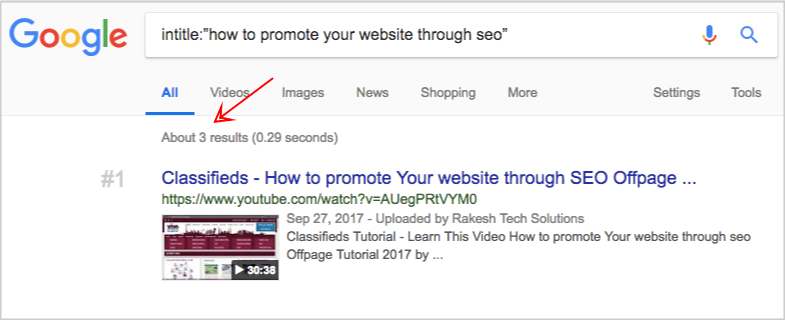
In addition to intitle search operator in order to quickly assess competition, you can make variations to check articles that fit to the category. You may use search queries like "website promotion" "seo", or "seo website promotion".
The reason you want to assess competition is not to bloat your blog with another similar article, but rather to ensure that there would be either a unique angle to the topic, haven't published yet topic so you may be the first to create or to target the exact keyphrase through long-tail form approach.
GENERATE LOCAL CONTENT INSIGHTS FROM YELP
If you're into local SEO, this technique can be a huge advantage for you.
Supposed that you want to produce more local sales pages, instead of going through the normal approach of using keyword research tools for key phrases like "pet care", why not reverse engineer a popular review website's organic keywords and see if they populate keywords you could target or haven't targeted yet for sales pages.
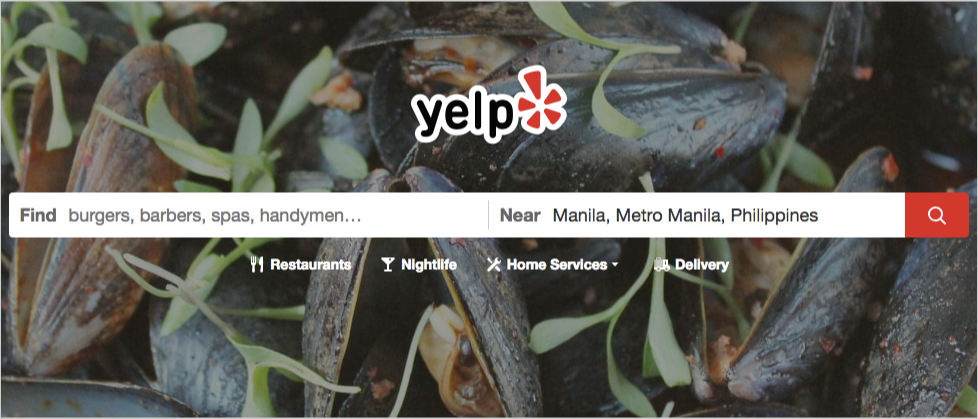
Start by entering yelp.com into an SEO tool of choice (I'm using Ahrefs for this example). Select their organic keywords section and filter results based on your industry topics.
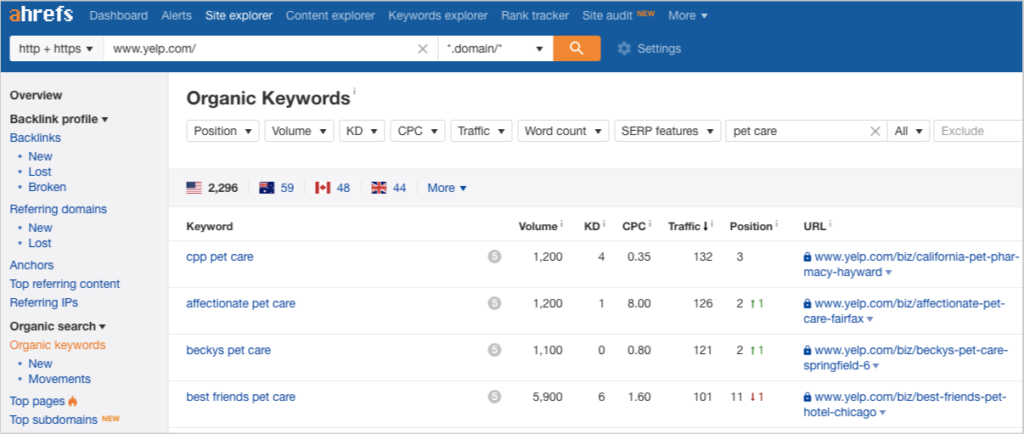
See for yourself which keyword is relevant to target for your local website's sales page.
REVERSE ENGINEER SLIDESHARE FOR VISUAL CONTENT
There are a lot of image link building strategies in the search space today, but one that's not really maximized to its full extent is reverse engineering top visual submission websites.
Slideshare, for example, dominates most of the reports, data, and visual-driven keywords.
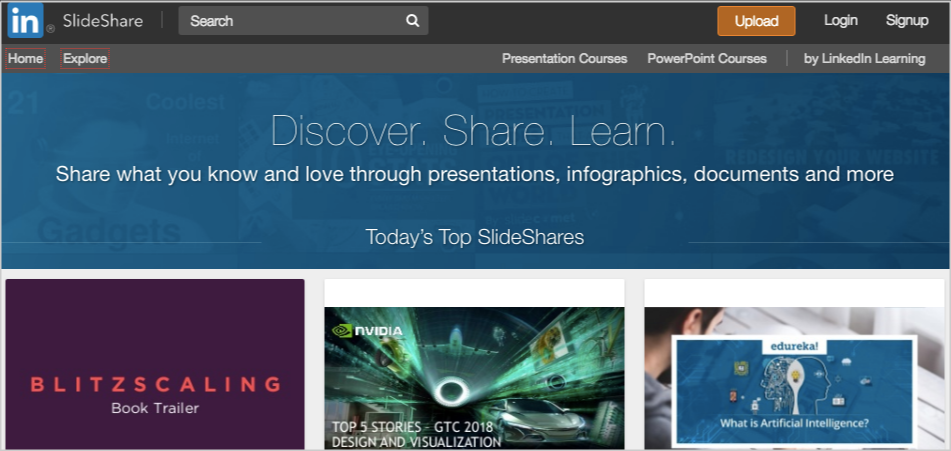
If you want to produce an infographic or create visual-oriented content, you can plug in Slideshare or other top visual websites and see what keywords they're currently ranking.
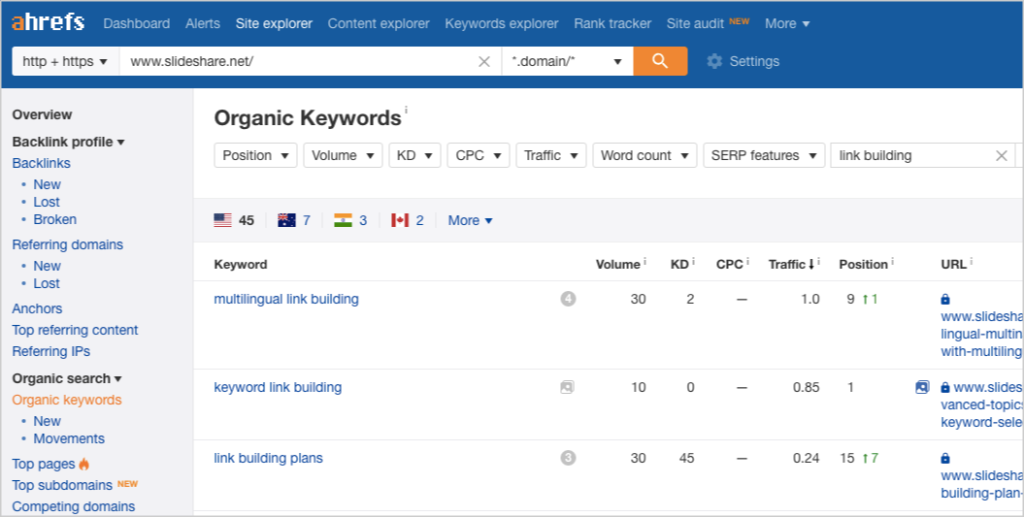
Filter these keywords based on your industry topics and assess which one you can target for your brand's visual content.
PUBLISH ARCHIVE OF STATISTICS
There is one powerful tactic that will help you consistently earn authority links over time and even get competitors backlinks, which is producing statistics content.
You can produce it internally if you have same data in place, or curate exclusive and premium reports from trusted statistic websites like Statistica.
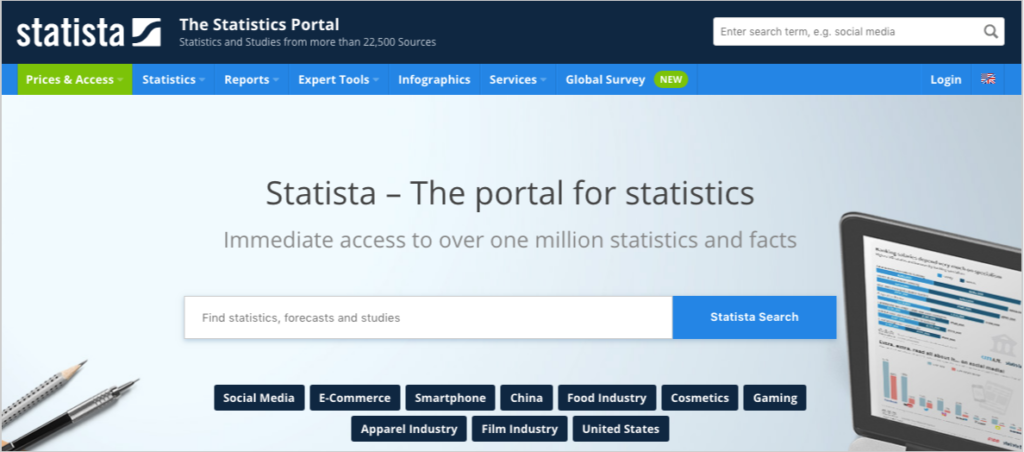
Moreover, if you see statistics reports brought up year over year, you can provide an entire archive of statistics on your website. Given that many people are searching for it every year, there's a definite value community is giving to such kind of report. In that sense, it's a huge advantage you can get if you have produced an entire archive of statistics.
REVERSE ENGINEER CONTENT WITH REDDIT
Reddit is a good place to develop your audience. It has only been misunderstood these days by some marketers banned because of their manipulative tactics to get more visibility in their subreddit of choice. But if you do things properly, you can get repetitive traffic from the website by submitting or putting out content.
One way to reverse engineer success in Reddit is to use Buzzsumo. Buzzsumo has an incredible feature of giving you Reddit engagements similar to the usual number of social shares (Facebook, Twitter) you see in every URL.
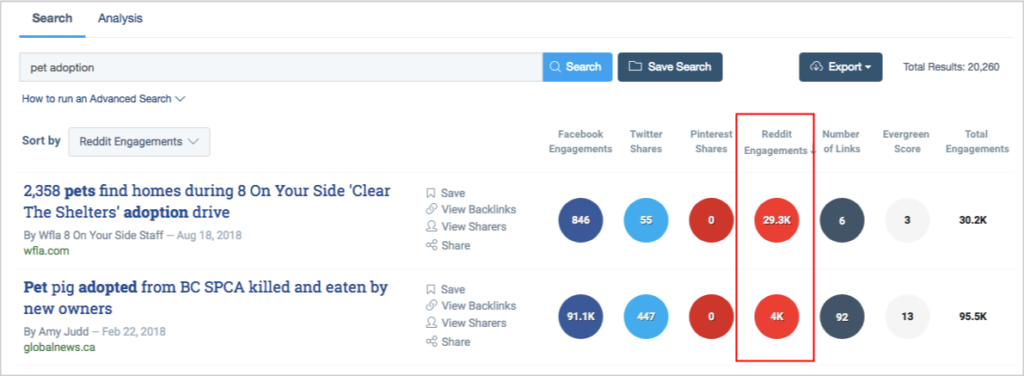
By looking at Reddit engagements, you can assess if the topic of your choice has the potential to get massive traction in its specified Reddit.
It's lazy behavior to make an assessment of the traction of a topic based on the overall total score from social shares and other websites' engagements. Given that each network or site has its own set of audience (with its own culture of engagement, interest, and style), it would be reasonable to stick on looking at one engagement score, in this case, Reddit engagements alone.
If you can find a topic with good potential engagement on Reddit, you can craft content that is suitable only for a subreddit.
One way to get the most out of your Reddit initiative is to submit content's URL to a subreddit during optimal times. You can use a tool like Later for Reddit to schedule your post at your desired day and time.
PROFESSIONAL ORGANIZATIONS
One way to promote your website is to make use of the professional organizations your company or entity has been a partner of.
There are Chambers of Commerce, industry professional organizations, and other similar sites you can contact for further promotion of your brand.
There are entities that will require recurring payment, some would love just a donation in exchange for a feature on a page or on a magazine or exhibit event.
Whatever it is, make sure you find them first and reach out to them whenever you see them fit your brand.
Start your link prospecting process by using any of these search queries:
- “KEYWORD” Business Association
- “KEYWORD” Directory or Business Association “CITY”
- “KEYWORD” Chamber of Commerce
- “POSTAL CODE/ZIP CODE” Chamber of Commerce
- “POSTAL CODE/ZIP CODE” Directory
- “INDUSTRY” association “STATE/PROVINCE”
- national “INDUSTRY” association
You can check out this guide for more search queries targeting professional organizations.
COMMUNITY ENGAGEMENT
Without any cost, every person can spend their time engaging the community. When I started my first blog, Digital Philippines (now redirected to SharpRocket link building blog), one of the things that I regularly did is to look for specific channels, networks, and websites I could provide value by asking and answering questions.
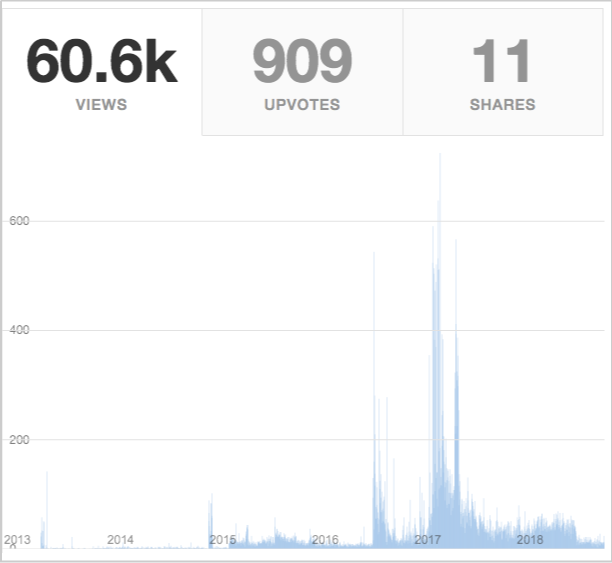
Most of the time, people think that you have to be an expert before you start going outside of your blog and looking for places for engagement. It's not the way industry practitioners work today. In fact, you'll find most of them just asking questions to one another, creating an Ask Me Anything section, and then rolling over conversations.
Here are some places where you can start promoting your website through engagement:
- Industry twitter chats
- Webinars
- Quora
- Community Blogs
It is important to monitor your performance in engaging the community and check which inputs will you give the maximum outputs in return.
One good approach is to choose specific questions on Quora that got traction already in the past and still getting more views given they're currently ranking for some informational keywords. If more people are searching for the question and have landed on the Quora question page, your answer may potentially get more exposure (adding up if your answer is marked as top answer).
DISCOVER AND PRACTICE
There are hundreds of ways to promote your website that I haven't covered here. But if you would like to take little steps in website promotion, start implementing the tactics above and see if they worked for you.
Discover more approaches to get traction for your website by reading SEO and link building blogs, guides, and ebooks. Practice them as soon as ponder them to be of use to you. There's no way you can say it works if you haven't executed it properly.
How to Start an Outreach Campaign
Starting an outreach campaign is easy. Executing it at the finest level is another story.
Outreach campaign initiatives vary depending on where you're at, what your goals are, and what are your available resources.
On Setting Up An Outreach Campaign
Where are you at?
I'm specifically referring to what you're currently working on. Do you handle clients as an agency? If that is so, is your agency focused on link building alone, or are you taking link acquisition as part of your SEO services?
Do you build links to a single website or to multiple properties of your brand?
Of course, you have some knowledge about this one. But knowing this is a must if you want to have a clear picture of your starting point.
What are your goals?
Have an end goal in mind. This speaks of what you want to achieve with your outreach campaign. Is it for PR purposes or are you trying to promote a content piece to get links?
An outreach campaign best works if it targets a specific goal/s.
What are your available resources?
Look at your current situation. Do you have any content specialists working with you? Any outreach specialists your company recently hired to become part of your team?
Did you subscribe to any premium tools? Buzzstream, Pitchbox, or NinjaOutreach, for example.
Not only should you be looking at your current resources, but you must also have an idea as to what additional resources you are willing to invest in. These include tools, more content and outreach specialists, or work offload from your current team members to be allotted to your outreach campaign.
Know these resources given as this will help fill in the gap between where you are and what your goals are.
How to Start an Outreach Campaign
There are certain outreach best practices to ensure an outreach campaign provides the most value to its end users (email recipients — i.e. potential linkers) and gets the most value in terms of content engagement.
Internal Content and Link Research Analysis
Start by knowing which of your current content assets you'll be using as bait for your outreach campaign.
Look at your existing blog assets. Which content piece has gotten relevant high-quality backlinks in the past? Once you've identified, check if there is still a market you can reach out with your evergreen content.
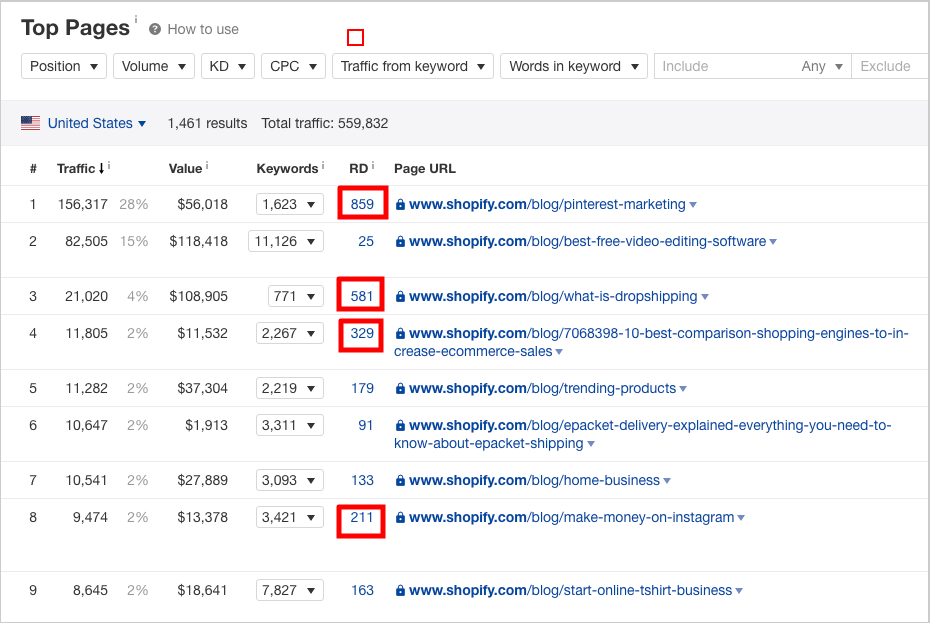
Outreach is tied to a specific content piece you are offering to the market. Start by knowing which makes the best offer.
Direct Extension of Prospecting to Outreach
If you think about scalability, you want to get the most out of your time for all of your outreach campaigns.
If you're handling multiple campaigns or even just for one website, one way to get more things done in less time is to extend your link prospecting initiative to outreach.
Instead of executing link prospecting and outreach separately, you can make them integrated by pulling some data from a third-party tool for gathered link prospects. Bring the targets directly to an outreach tool or platform for pitching.
You can use Ahrefs to pull some huge data of backlinks from competitors' sites (or other relevant sites to your brand).
On Ahrefs, you can qualify links through filtering by Platform (e.g. Blogs) and to One Link Per Domain. You can also use the included search to get only relevant pages. By including topical words, you exclude ones not related to your target campaign.
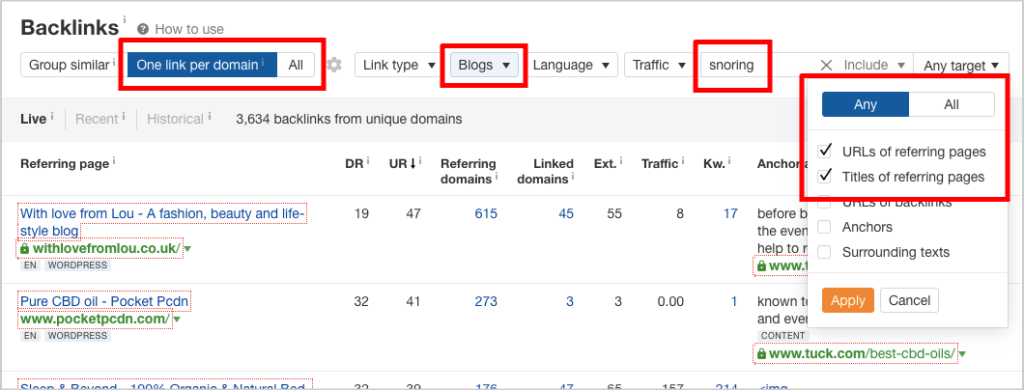
Once you've exported the links, you can strip the URLs to root domains using any URL trimmer tools: https://manageguru.com/url-trimmer
You may quality the links further for relevance by manually checking them one by one.
Input your list to email finder tools like Hunter and VoilaNorbert. Through any email outreach platforms or Gmail plus extension tools, you start sending outreach emails.
Outreach Segmentation
There are many link prospecting methodologies from different agencies and specialists on outreach. Those that have the most value include segmenting the list into different groups. This leads you to do some outreach for influencers or just for resource curators or blogger outreach.
Outreach segmentation helps you prioritize link targets based on your current link strategy, audience type, and potential link value the target page can provide.
Basically, metrics like Ahrefs' DR/UR, Moz' DA/PA, or Majestic's CF/TF can assist you in knowing which link targets are valuable.
But don't stop there. Look at possible link types. Are those websites more driven as PR or contextually driven for link building?
Segmenting your outreach lists also includes knowing which backlink prospects you've had connections with in the past. Given that you'll get higher chances of recurring links from people who've known or have interacted with any of your content, than someone you'll be reaching out to for the first time.
Organization of Prospecting and Outreach Lists
The simplest way to organize your prospecting list is to use a free tool like Google Sheets. If you're not really fancy with organization, you may start with spreadsheets and labeled columns for outreach details.
For bigger outreach lists, outreach platforms like Buzzstream, or Pitchbox will give you better organization for your outreach lists.
Here are some guides to help you with organizing your prospecting lists using spreadsheets and extensions:
- 100+ Google Sheets Templates
- 26 Best Free Chrome Extensions for SEOs
- Advanced Google Chrome Bookmarklets for SEOs
Quality audit on outreach templates
Scalability requires outreach templates.
While that gives you the leverage to speed up sending emails to hundreds and thousands of potential linkers, you care more of value than a mere personalization.
Fake personalization is worse than no personalization at all. @buzzstream found that a fake compliment such as "I read your post and loved it!" actually has a -1.3% impact on placement rate as compared to zero personalization.
— Ross Hudgens (@RossHudgens) May 7, 2020
Get some feedback on your outreach templates from the frontlines of your outreach team (ones who're in conversations with linkers).
Do some quality audits of your past outreach campaigns either for the same content piece or for a specific client outreach project (guest posts or resource page campaign you did)
Check conversations that have gotten you links and ones that don't. You'll have a better understanding of what makes your email resonate with the linker.
Follow up email process
What separates a successful outreach campaign from a mediocre one is a meticulous system for follow-ups. Most outreach teams take follow-up email structure for granted.
You miss a lot of opportunities for link targets you didn't send some follow-ups.
Have a follow-up system for people who are out for vacations, who'll get back to you when they can but never replied, and people who've seen your content, but are asking for some more requirements (either in content format, messaging, or contact information).
Outreach is an ongoing process
As much as you consider the results of your outreach campaign, identify how to make your process better than before.
With systems and the right strategies and resources like tools and people, you'll penetrate an interesting market for links with your outreach emails.
The Definitive Guide to Blogger Outreach
What is blogger outreach?
Blogger outreach is the process of building genuine relationships with industry publishers and bloggers to find a common point of interest where both ends will benefit.
At SharpRocket, thirty percent (30%) of our work is spent on blogger outreach. Making sure that every email penetrates the inboxes of recipients and secures positive responses, requires us to strategically prepare the outreach list before they are sent away.
In this guide, I’ll walk you through the exact outreach tactics we’ve implemented to our clients plus tools that we utilize to improve the entire process – from gathering contact information to nudging bloggers to link to the content.
Other Definitions of Blogger Outreach
Before getting straight to the how-to section, let me give you some definitions of blogger outreach from what we’ve considered as linker outreach veterans.
Blogger outreach is the process of contacting bloggers through any communication medium for the purposes of collaborating on projects, such as giveaways, content publishing, or sponsored posts.
Ross Hudgens, Founder of SiegeMedia
Blogger outreach is a marketing channel, which involves building relationships with bloggers to form mutually beneficial partnerships. The aim of these partnerships is to effectively promote one's business, while simultaneously providing value to the blogger and their audience.
Dave Schneider, Founder of Ninja Outreach
5 Blogger Outreach Best Practices
What makes practices best in their natures are small differences that can take mediocre emails to outreach emails that convert into high-value links. When others are looking forward to new strategies or tactics that can be tried and tested for a change, there are small overlooked details you can already apply to create success for your next outreach campaign.
1. Tracking Open Rates With Mailtrack.io.
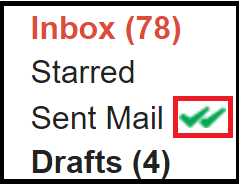
One missing metric of many outreach campaigns we’ve encountered is the open rate. Open rate is basically the ratio of emails opened (whether they landed a coverage or not) over emails sent.
If you are handling several outreach campaigns, you get to overly focus on emails that received responses from bloggers and tend to overlook opportunities from emails opened yet not replied to.
If you can track the latter type of emails, you can build potential equity you would have missed if you remove it from your outreach database or you just follow up with them with the same initial email template.
One best outreach tool that can aid you with this is Mailtrack.io. This blogger outreach tool enables you to know if emails had been sent to their proper places and if the person you’re reaching out to opens your email. This provides you insights to better understand the majority of your outreach prospects. If a person reads your email but didn’t respond to it, you can draw hypotheses from these:
- Your content offering doesn’t cut through the interest of the blogger.
- Your subject line attracts but had no relation to the body of your email.
- Your email is fully promotional in nature.
From this hypothesis, you can take actionable measures which you can read in the latter part of this guide.
Back from the great functionality of the tool, Mailtrack.io offers the said feature for free. So if you are weighing budget with outreach ROI, the tool helps you save product costs.
2. Encouraging Response With A Content Proposition
Mediocre outreach specialists send emails with naked URLs to view their content. Without trying to describe what the content is all about and how it does help bloggers’ readers regarding a topic, the email is near the same as spammy bulk blasts. Both don’t provide enough value.
Instead, you’d want to capture the blogger’s interest by stating the unique proposition of your content piece – know what differentiates your content from others and explicit it. Including social proof in your email also builds credibility to your content - e,g, how many influencers had shared your content asset.
Besides content proposition, there is also one way to leverage interest – that is, visitor engagement. This is often stated in broken link building campaigns which goes like, “If you fix the broken link in your resource page, this will help your visitors find the referenced resource”.
Apply this same principle to blogger outreach. You can structure emails that end something like this:
If you think adding more interview related references to your page can make your website visitors engaged, let me know if you'd like to see it.
With this type of proposition-based call-to-action, you encourage more positive replies from bloggers instead of letting them view only your piece.
3. Leveraging Specific Subject Lines
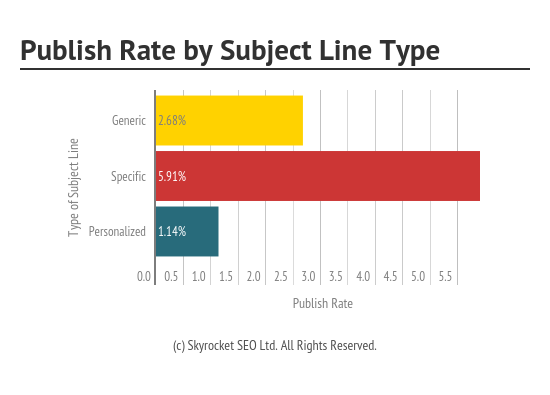
Personalization gets so much attention from the link building community, particularly those whose main task at an agency is outreach. It’s easy to pre-conclude that because an email is personalized, it would help the content earn links instantly.
That’s not always the case. If you’re crafting a long customized email, the person who will be reading this would lose his interest at the start. Brevity lacks in some way.
That said, one good piece of advice here is to segment your outreach list based on priority – identify which bloggers needed to pitch emails with a strong level of attention. For low to medium-level bloggers, you can create an email template with specific subject lines, such as, “hoping to be included in your career resource”, which would only require small tweaks in the email replacing attribute tags such as name, site name, and target page.
In their latest outreach data, Skyrocket had seen no evidence of getting better results by crafting personalized subject lines in emails (see image above). Besides ease in crafting individual emails, there is uniformity among outreach specialists who work on the same blogger outreach campaign. Also, it saves a ton of time.
4. Highlighting Attribute Tags
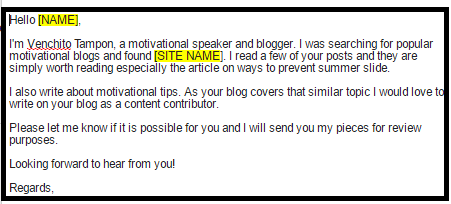
As a company that loves outreach, crafting email copies is essential in scaling the initial blogger pitch, which are structured in such a way it could be customized for certain people. This provides us the luxury to spend more time in relationship building once the conversation started, instead of exerting extra efforts to fully personalize emails.
Keep in mind that because email templates are great, they aren’t prone to some human errors. If you happen to send emails to editors without replacing one of the attribute tags ([name], [site name], etc..), you end up losing the potential equity you would get from the conversation you try to make with the editor.
More so, if you aren’t careful with replacing attribute tags with website details, there are possibilities of receiving replies that say, “that is not my website” or “you should have researched my website first”.
One minor error in tag replacement is a major error in the entire outreach process.
If you value every single outreach prospect, one tip here is to highlight attribute tags when constructing email copies or canned responses, so if you feel you have forgotten one of the details, you can easily skim the entire email draft before actually sending it. If Gmail is your preferred outreach platform, it is a lifesaver option to enable the Undo feature –which helps you to revoke your mistake.
5. Bridging Conversations Through Email

If you’re not maximizing other mediums of communication aside from email, you’re missing out on opportunities that might get you to faster coverage of links.
At SharpRocket, we’ve tested using Twitter in our link prospecting phase and we’ve found great blogs out of it. It also gives us a clue that there are visible industry blogs in this social platform that if we’ll be going to reach out to, we can bridge relationships that can convert into links.
Creativity matters in blogger outreach. If you’re an outreach specialist, you shouldn’t just sit down when you can’t contact the person through email, but find at least two other ways to approach the person.
Initially connect with the outreach prospect using social media platforms like Twitter and bridge the latter part of the conversation through email. There are a few good reasons why I think this workflow works. First, you avoid communication errors caused by email technical issues. Second, you can validate the email to contact to by asking it straight to the Twitter handler (blogger).
Here’s an example of an exact email that shows how this practice works:
Writing this further to our conversation on Twitter (I'm @nirajr). Great to be connected.
6 Blogger Outreach Tools
This definitive guide to blogger outreach isn’t complete without tools that can aid you with the entire outreach process. So here is a list of tools that I highly recommend and we have actually used and tested for our clients, which you can also try to take your campaign to the next level.
1. Email Hunter
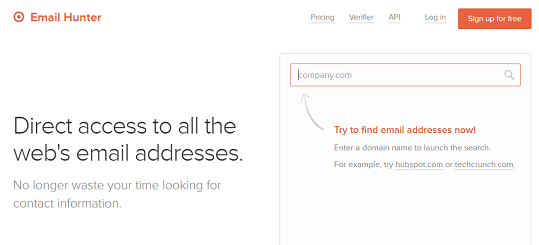
Email Hunter is a great freemium tool in finding email addresses without actually dumping to each individual pages of the website to collect the contact details. It’s definitely a time-saver tool for bulk lists of outreach prospects that might need hours for manual searching of email-addresses.
However, when Email Hunter pulls out data, it would provide a long list of contact emails, so you have to manually choose which email to contact to (preferably this kind of email format – name@domain.com). Later this guide, you’ll learn about our list of prioritized email formats that respond to pitches we make.
2. MAIL TESTER
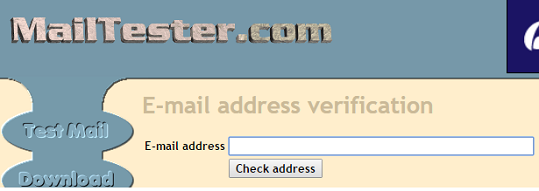
If you’re doing blogger outreach for years, you probably would agree with me that an outreach campaign usually comes with “Mailed Delivery Messages”. If you skip these errors and you try to find secondary emails to replace them with, you can consume some minutes, which should have been used for other outreach workflows.
You can avoid said type of messages by validating emails before you actually pitch them. Mailtester does help determine if emails are of good use, which minimizes your time searching for secondary-level emails.
3. BUZZSTREAM
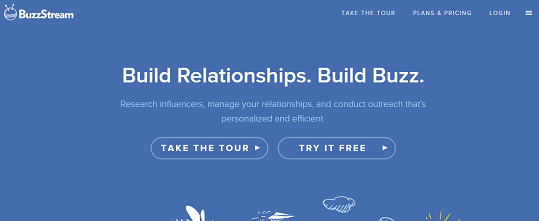
If you land on a website and you want to contact the blogger straight from the browser, you can do so with Buzzstream’s Buzzmaker tool. The tool gives you the luxury to execute immediate blogger outreach without using the main outreach dashboard.
Buzzstream lets you also track emails that converted into links and enables you to label emails with specific relationship levels, so you can monitor which ones should be prioritized.
The said tool works effectively for large teams of link builders and outreach specialists.
4. PITCHBOX
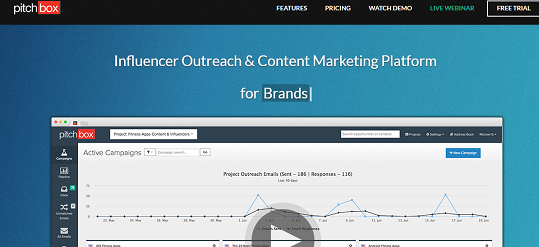
Designed for small teams of link developers, Pitchbox allows you to automate follow-ups and consecutively send them to bloggers with a set amount of time interval between each follow-up. If there is no reply within the first days after an email has been sent, the tool sends another follow-up email – which takes away the trouble of checking if the next set of follow-ups cut through the inboxes of outreach prospects.
Additionally, Pitchbox’s difference-maker is the ability to create pre-built reports – a definite time-saver for outreach managers wanting to grab email data (i.e. number of email responses vs number of emails sent). Instead of manually computing these numbers, you can automate the reports by clicking on buttons.
5. NINJA OUTREACH
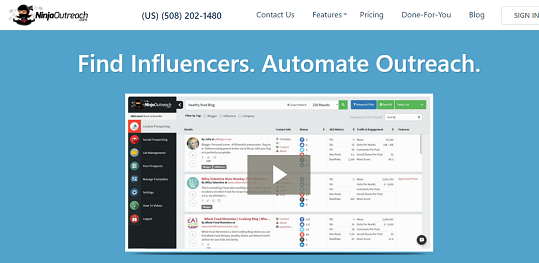
Ninja Outreach’s handy feature from a blogger outreach perspective is allowing you to pre-fill contact forms with email templates upon visiting contact pages of blogs. If you guaranteed that a certain person is qualified to reach out to, the said feature of Ninja Outreach saves you time not revisiting them for future outreach.
Generally, if you have a basic to intermediate level knowledge in the overall blogger outreach process, the tool has an easy user interface that helps you execute everything from link prospecting to email outreach.
6. MEME GENERATOR
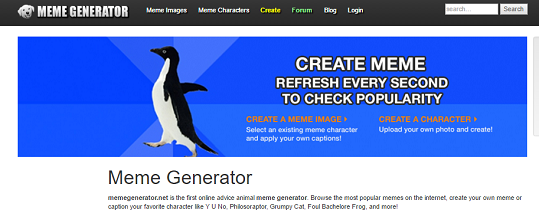
For saturated niches where bloggers receive dozens of emails every day, it’s ineffective to send emails that almost look like other blogger pitches. While it’s true that content can speak for itself, transitioning your emails from good to great necessitate your email to stand out.
One way to do this is to tweak some parts of your email that will add humor to your message but still encourages bloggers to respond to your pitch (see image below) - hat tip to @seoteky.
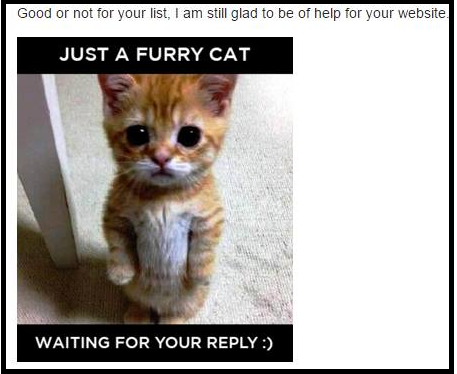
THE SCIENCE BEHIND EFFECTIVE BLOGGER OUTREACH
Data, in particular psychology studies, leverages the results of the entire workflow of blogger outreach – as it reveals things that needs improvement or removal and helps plan strategies that almost-predict results in the next campaigns.
Below is a curated infographic of external research studies generated from analyzing thousands of emails sent to different people. This will definitely help you craft outreach emails that guarantees more than average success.

Share this Image On Your Site
If you’re looking for more supporting data of this infographic, here are the step-by-step breakdown on the science behind effective blogger outreach.
USE CC FOR TWO RECIPIENTS
When gathering contact data of publishing sites, you mostly see that twenty percent (20%) of these blogs are coupled with multiple authors and/or team of editors. This may raise confusion on which one of these people you should be reaching out to.
At SharpRocket, we had a solid chronological preference on which email should be collected first.
- Visible email - find the most visible contact email on the page (for resource page) or on contact pages - domain.com/about or domain.com/about-me (for blogs).
- Personal email (e.g. venchito@digitalphilippines.net). Use Rapportive or Clearbit to validate if it’s the actual email being used.
- Contact page of the sole author
- Department / Position-based - identify the person who is capable (at most) of accessing the website and editing the article/page.
- admin@domain.com
- editor@domain.com
- info@domain.com
If there are several emails to choose from, collect two of them and save it to your database.
In the study conducted by Yesware, they’ve found out that emails sent to one person while cc’ing another are 12% more likely to get response than email sent to two people.
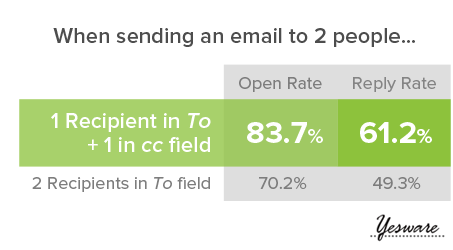
The probable reason for this is that the one person who directly receives the email has the responsibility to take an action, because there’s another person looking at the email. This also encourages the other person to reply if the primary action doesn’t take place. Needless to say, you can receive more response by only sending an email to one person while cc’ing the other recipient.
One quick note here is do not try to get the following email formats from prospect sites, as emailing them would directly go to support, customer service or sales group - they won’t take time if your pitch isn’t product-related.
- sales@domain.com
- support@domain.com
- service@domain.com
- hello@domaincom
- office@domain.com
The next best option when these emails are only available in the website is to grab the site’s page where it locates the contact form. Then direct your pitch through that form.
MAKE SUBJECT LINES CONCISE
ReturnPath shared an interesting study on subject line usage, which shows that 49 subject line characters or less gets 12% open rate and 75% CTR higher than those with 50 characters or more.
This may require immediate testing to make results possible for your campaign, but in essence, the reason it works is the brevity of the subject line.
Make your subject lines straightforward so busy bloggers could get the whole point of your message – definitely makes your email stand out.
REFERENCE PAST ENGAGEMENT
What most link developers or SEOs didn’t truly understand about relationships, is its ability to create a flywheel of links with low maintenance cost and efforts. When you connect to publishers, particularly those that gained mutual content benefits, it’s a less hustle to distribute a newly-released content to a target audience if you have a network of publishers to promote your resource.
Use this to your own advantage.
A smart outreach strategy starts an email with a reference to any past engagement with the publisher. Whether it’s a Twitter conversation or a recent offline interaction, a statement indicating a relationship gives a cutting edge to outreach results.
Buzzstream and Fractl found that 66% of publishers are more likely to open an email with a subject line referencing a past relationship. This added small detail to subject lines makes a big impact, if executed properly.
PERSONALIZE SALUTATION
If you want to get higher ROI from outreach efforts, personalization is a must-have rule when crafting an email. While this part is a no-brainer, many still ignores its power. If you send a pitch to email formats like editor@domain.com, when the site has its own about me page, it’s easy to conclude that you didn’t spend a minute researching even just the name of the blogger.
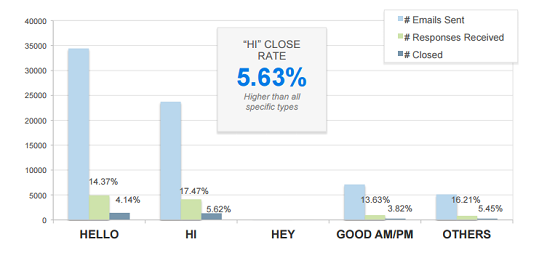
Additionally, using “Hi” as your greeting can improve close rate 5.63% over all other specific types based on iAcquire’s lessons in analyzing 300,000 custom outreach emails. There is no particular conclusion from this, but somehow reflects on the idea that greetings like “Hi” is commonly used in normal conversations.
WRITE SHORT EMAILS
Brevity in subject lines complements with short body email messages. Among thousands of emails, SiegeMedia concluded that the highest converting email length is an average of 83 words. Their hypothesis? Short enough to be easily readable, long enough to be customized.
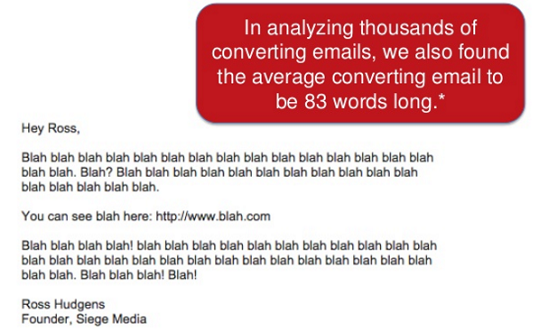
Be careful though when you customize email copies and before hitting the “send” button. You can get messed up by not replacing attribute tags (i.e. {Name} and {Site Name} or using two email templates in one email – one copy is at the bottom of the email (not visible at first glance).
USE SOCIAL PROOF
In email outreach, mentioning a social proof in the body of an email breaks the stranger barrier between the sender and the recipient.
When you include a mutual connection in your email, either a colleague, decision maker, influencer or popular publisher, it signals that you valued the opinions of others. This takes cues that you’re being related to a particular person they might know, which easily builds trust.
Studies of Yesware show that emails with social proof get 33% reply rate. Content-wise, if you’re being asked to promote a certain content, you wanted to know if the resource has gained some traction already, guaranteeing shares and additional links to your site when it is promoted.
A few social proof examples that are worthy to be mentioned in your email:
- 3000+ shares on a piece you’ve shared recently
- Contributor’s badge for a large publication site
- Number of publications or media exposures you’ve been featured in
- Name of industry experts you collaborated with
INCLUDE TRUST SIGNALS IN FOOTER
Aside from social proof, there is also one trust signal that can drastically increase your campaign’s link acquisition rate – that is, branded logo. If you’re reaching out to bloggers in behalf of a client or your company, adding a branded logo to your email makes success possible.
A few statistics to consider, gathered from iAcquire’s outreach case study:
- Emails without logos – close rate at 3.72%
- Emails with embedded logos – close rate of 6.03%
- Emails with linked logos – 10.58%
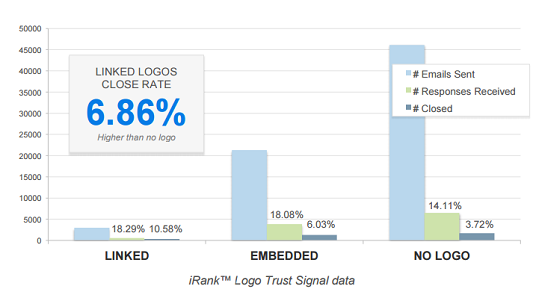
If you’re working in an agency as an outreach manager, ask permission from your clients first before sending emails to bloggers with embedded company logos. Some white-label clients don’t want their brands disclosed in the blogging community – outreach specialist will act as a generic content marketer finding the resource worthy to be promoted.
SEND EMAILS EARLY MORNING
Bloggers either full-time writers, in-house specialists or business owners have their own specific hours in a workday to check email inbox. Taking advantage of this increases the chances of your outreach emails being opened. So the next time you pitch bloggers for any reason, consider the best day of the week and best time of day where they’ll likely see and prioritize your email.
Buzzstream and iPullRank found that email sent between 1AM and 9AM return the highest placement and response rates. Hypothetically, if you schedule emails in this range of hours, you’ll increase the chances of getting your emails read and prioritized by your target bloggers for emails responses.
Additionally, pitching emails at best email reading days converts better than them on any particular day.
In the recent study by SiegeMedia, it shows that Monday is the best day to send initial outreach emails among other days. Monday emails also converts 80% better than Thursday.
In my opinion, Monday works best primarily because it is the start of the working day. Bloggers have the energy to respond to as many relevant emails they supposed to answer.
WITHHOLD LINK IN INITIAL EMAIL
I’m not a fan of being aggressive with email outreach. We usually pitch customize emails explaining why our content piece is worthy to be read and shared. Emails don’t include a naked link to view the content but rather just asking bloggers if they are interested to take one look at the resource.
SiegeMedia has the same approach with us of forgoing the link, to “catch and hold” the interests of bloggers. Once the interest has been captured, the next step is to maintain it. .
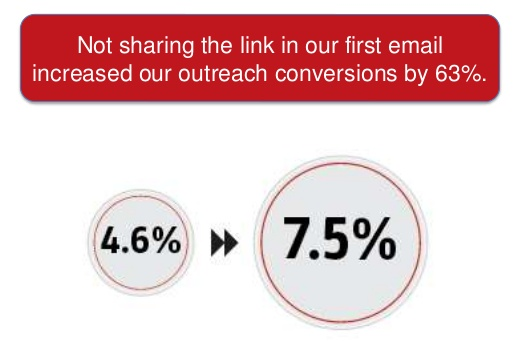
Starting the conversations first and keeping their interests until they decide to reference the work/resource better results to links than carelessly landing an email that gets to auto-spam filters – another reason why withholding the link in the initial email is preferred.
FOLLOW UP PEOPLE
Hubspot found that 50% of emails are opened in the first 24 hours. After 24-hour timeframe, 80% of emails were opened within 12 days of being sent.
If you didn’t receive any response after the initial outreach, you can follow up bloggers to increase chances of getting additional responses.
A silent conversation is worse than a solid “no” response. If you don’t get a response, you are stuck with a decision whether to continue the conversation or proceed to another prospect in the list.
If you decide to send follow-up messages, be mindful that too much of it can irritate the blogger – potentially can burn bridges along the process.
One way to avoid this is to send one last follow-up message to know the reason why they never had a chance to get back to you.
At SharpRocket, we send an email listing down three common reasons of silence and encouraging bloggers to choose one.
Here’s an email template we send to publishers.
Hi [ Name ],
I haven’t heard back from you, and that tells me one of three things:
1) You’re not interested at this time, but we can work out something in the future.
2) You’re still interested, but haven’t had the time to get back to me yet.
3) You saw our content but you think it’s not fit to add to your page.
Please let me know which one it is, because I’m starting to worry. If you have other reasons, please let me know so I can stop bothering you.
Thanks and looking forward to hearing from you.
[ Name ]
This follow-up email enables us to act on issues immediately, such as:
- Get back to the blogger when there’s another content/resource to offer.
- Schedule a custom follow-up to get an update after some time (for case 2).
- Improve content based on the feedback of the blogger (for case 3).
Based on our data, 70% non-respondents to first email would reply to a follow-up message above. This saves a lot of time for outreach specialists as they don’t need to reach out to the prospect again if the blogger decides not to be contacted again.
FURTHER READING:
Blogger Outreach The Right Way
Have We Been Helpful?
Want to take your link building to the next level – — but don’t know where to start, and are feeling overwhelmed by this post.
We are here to help you. SharpRocket is a team of link building specialists who love building high quality links.
To learn more about how we can help, take a look at the services we offer.









